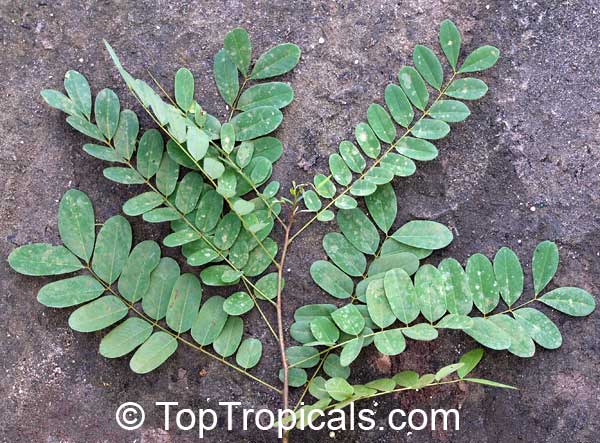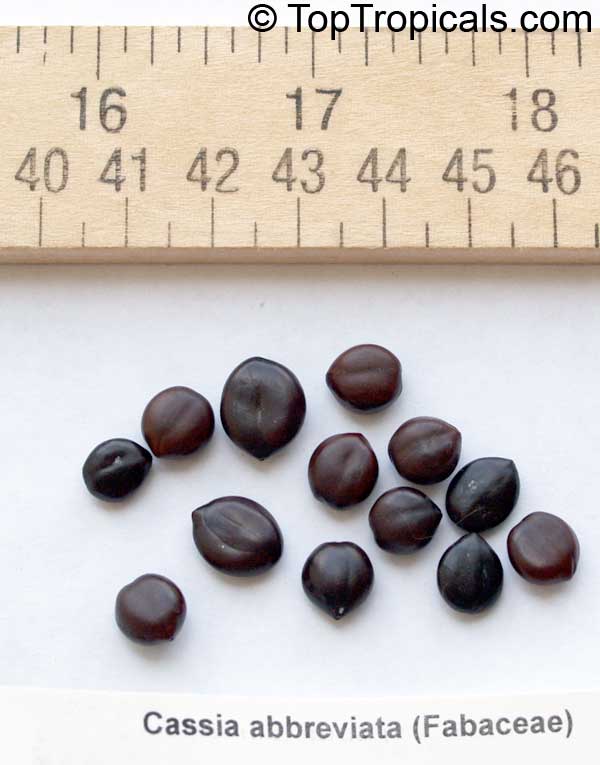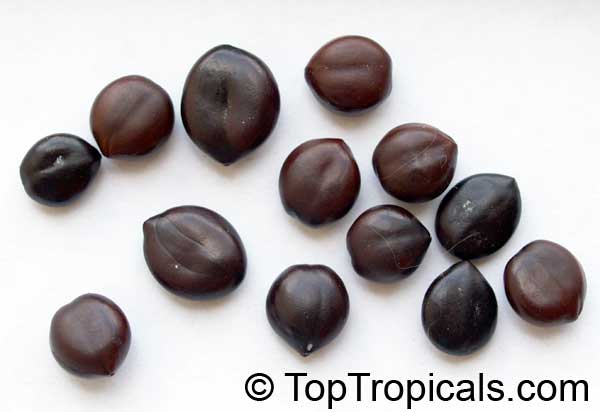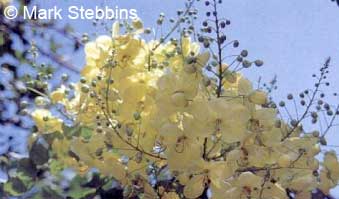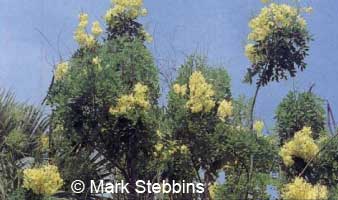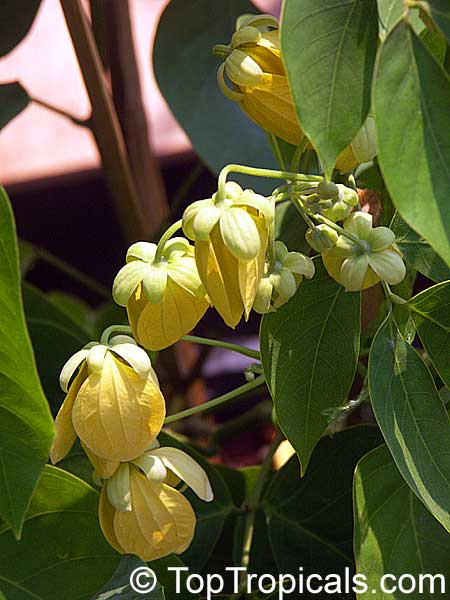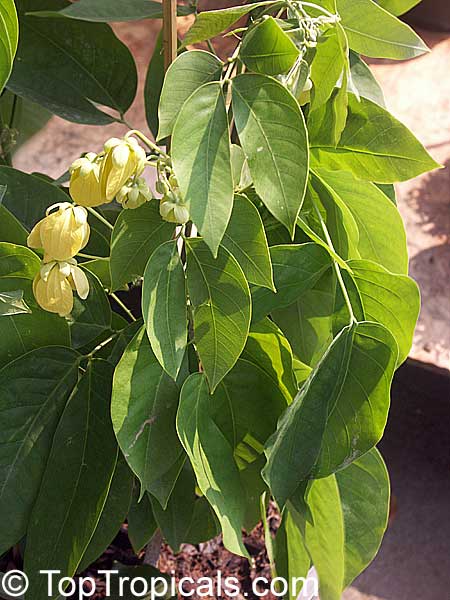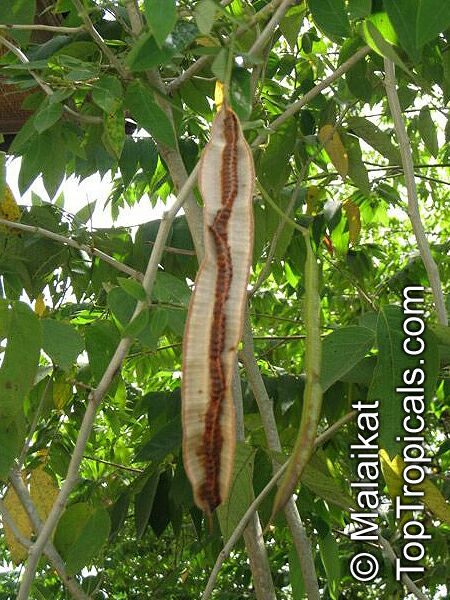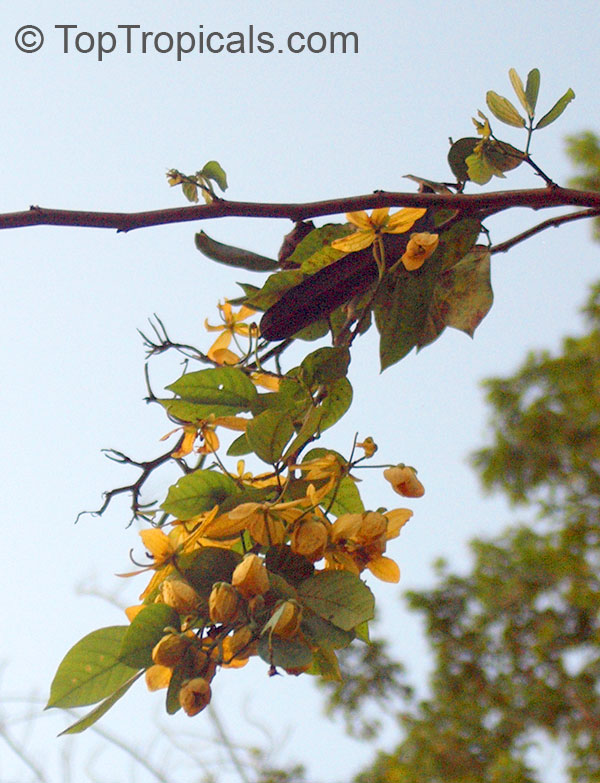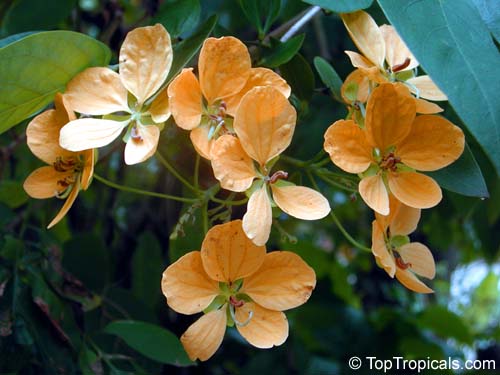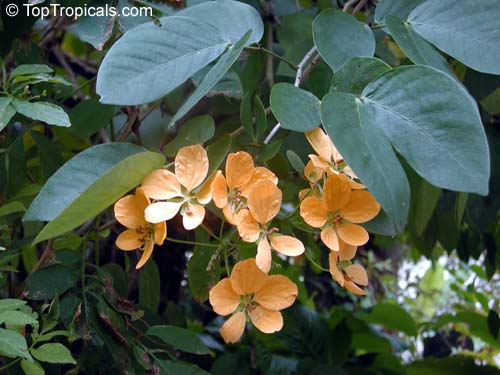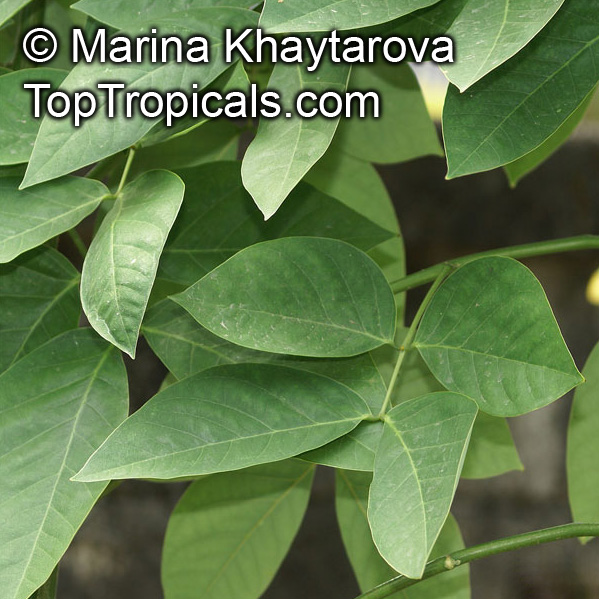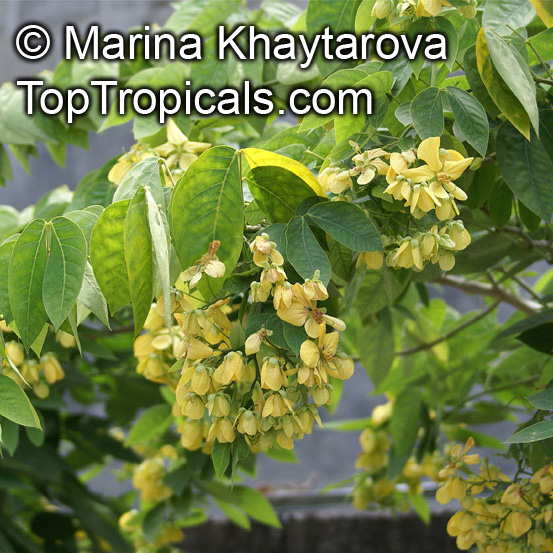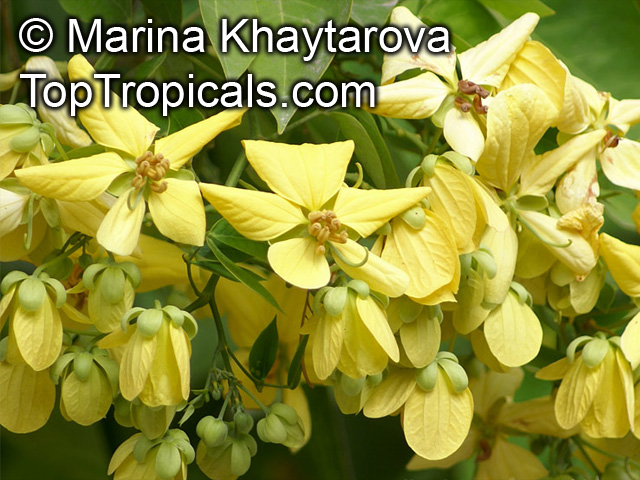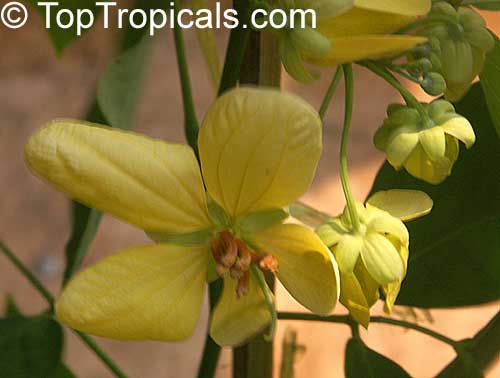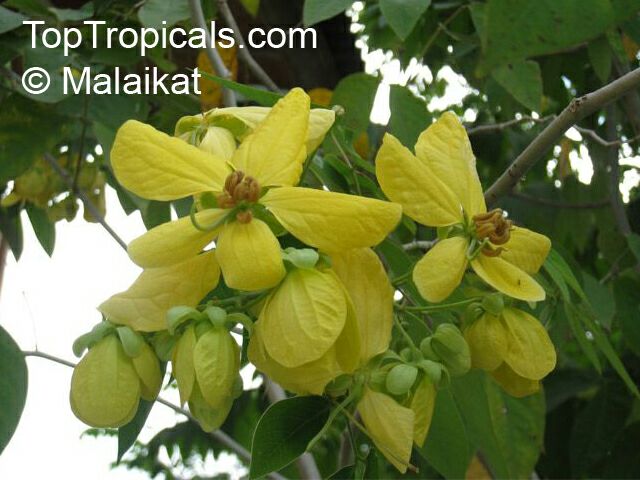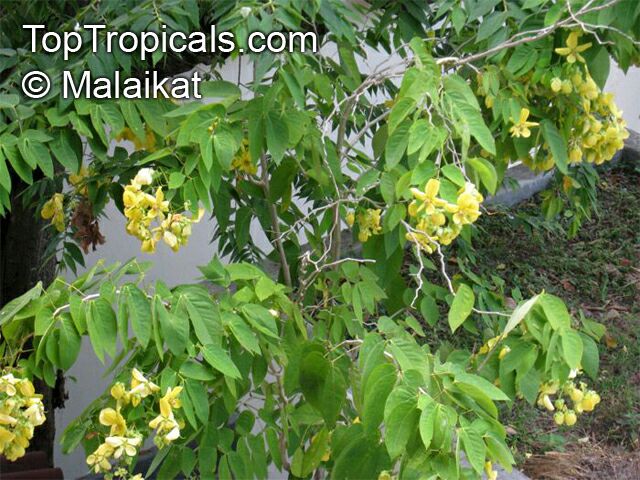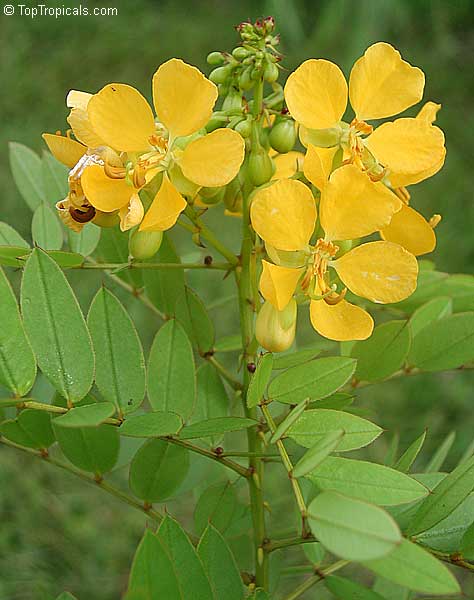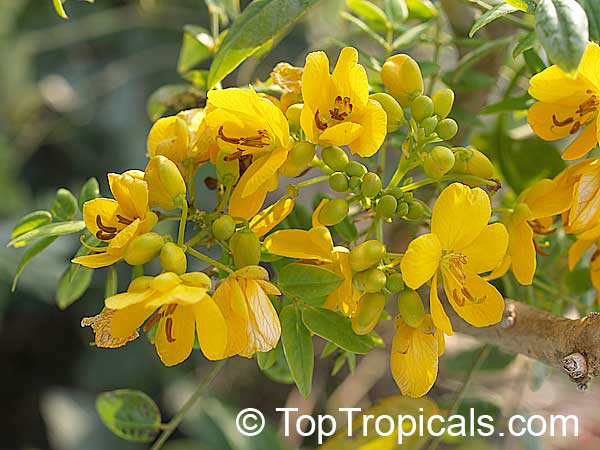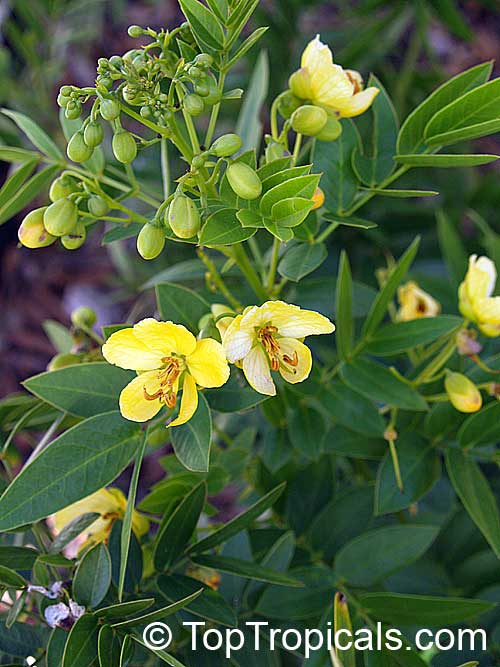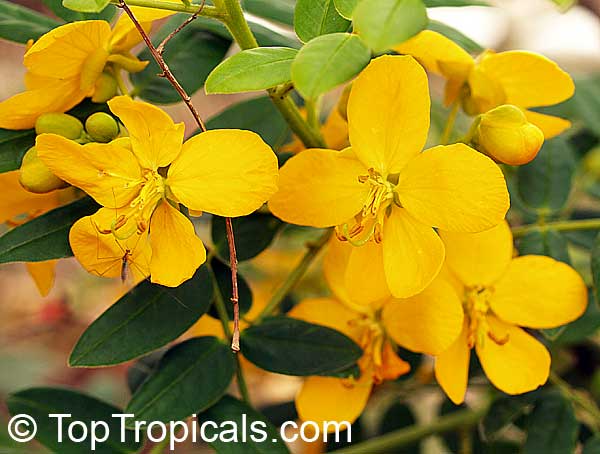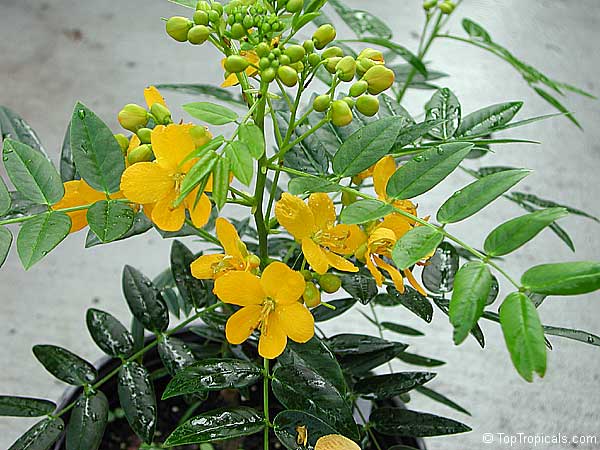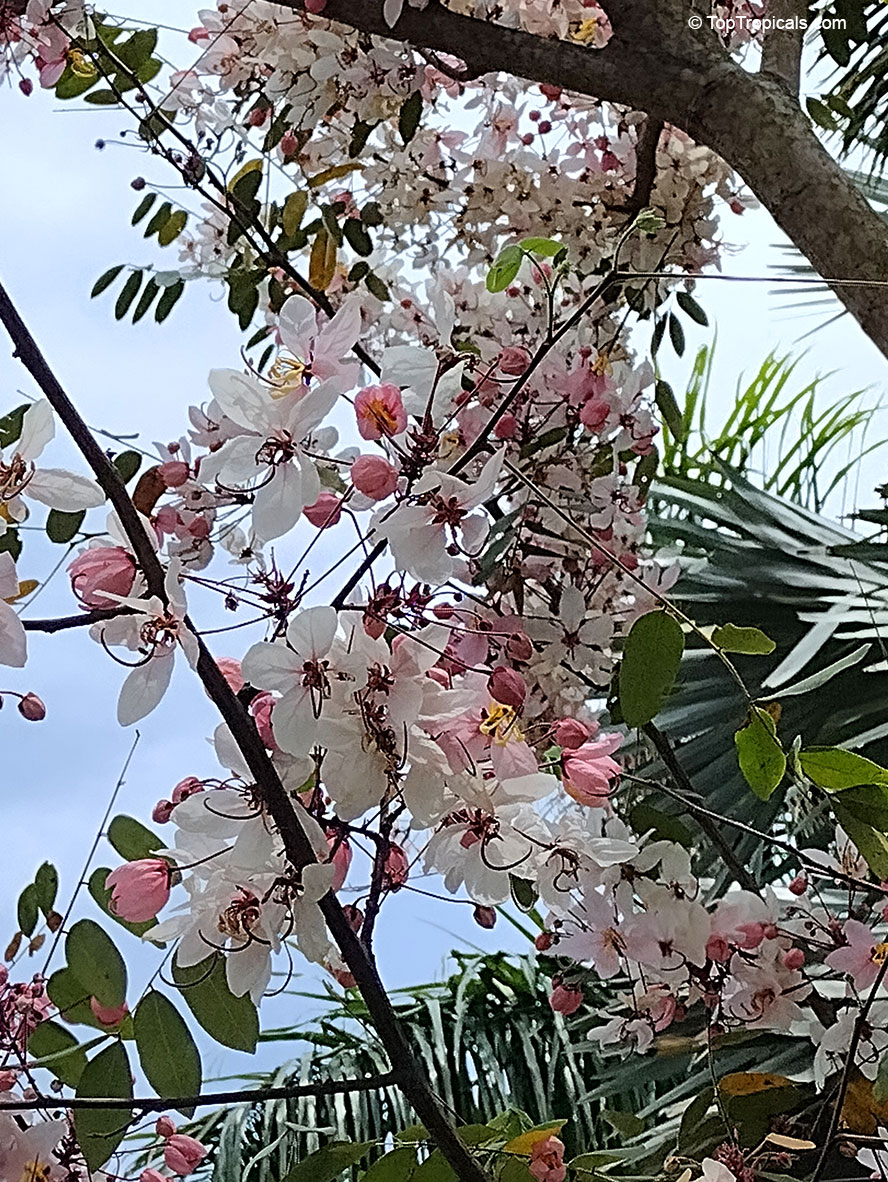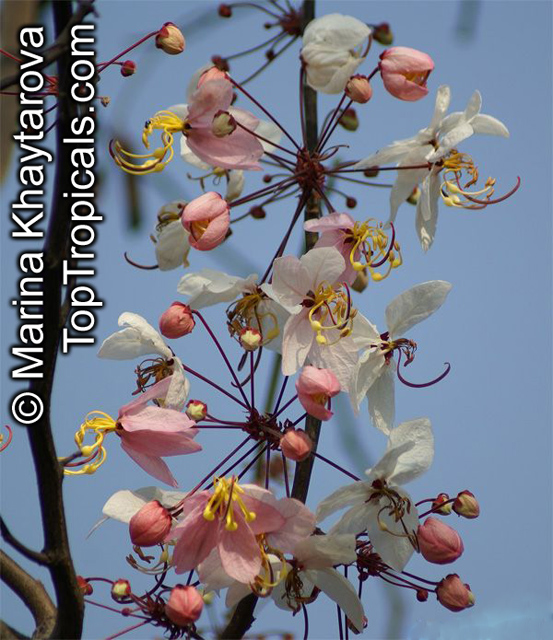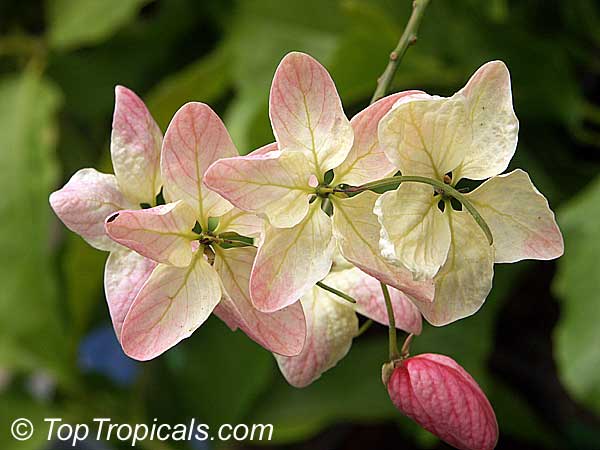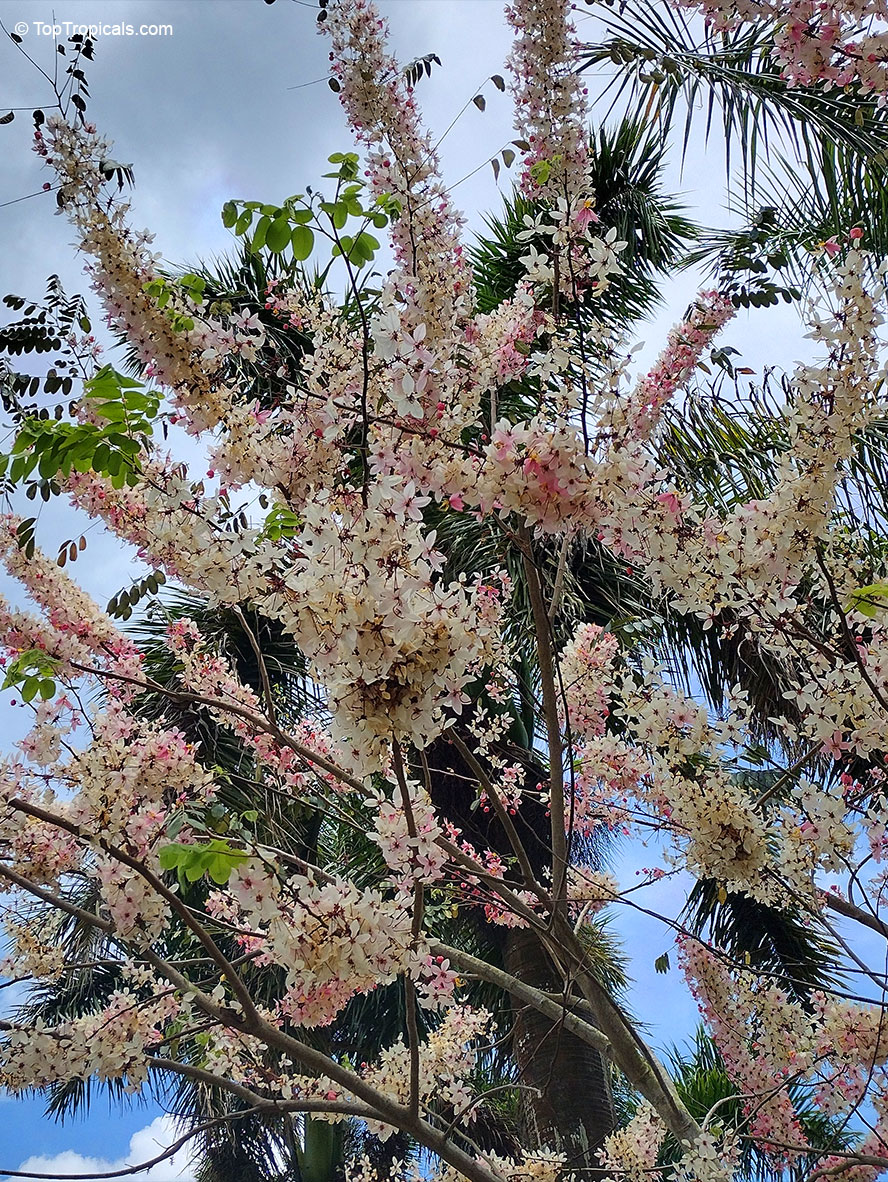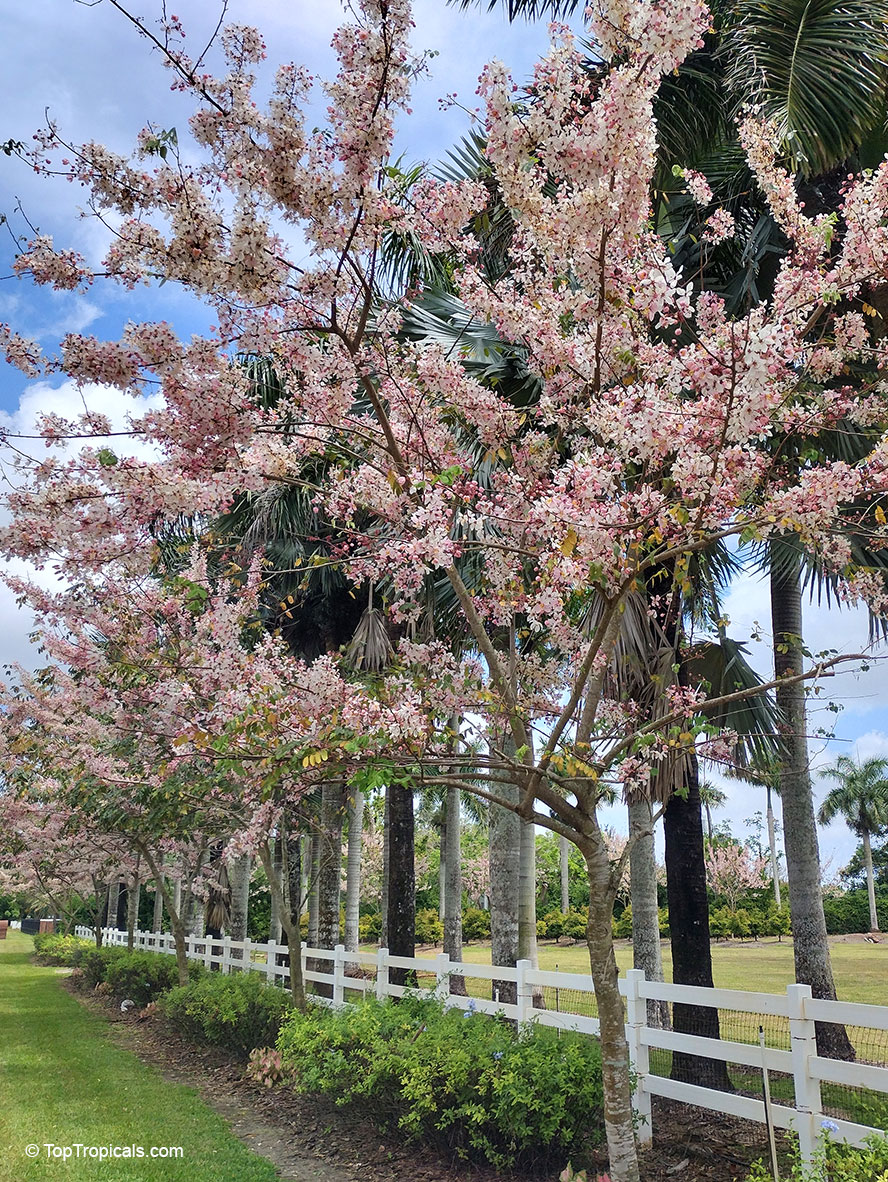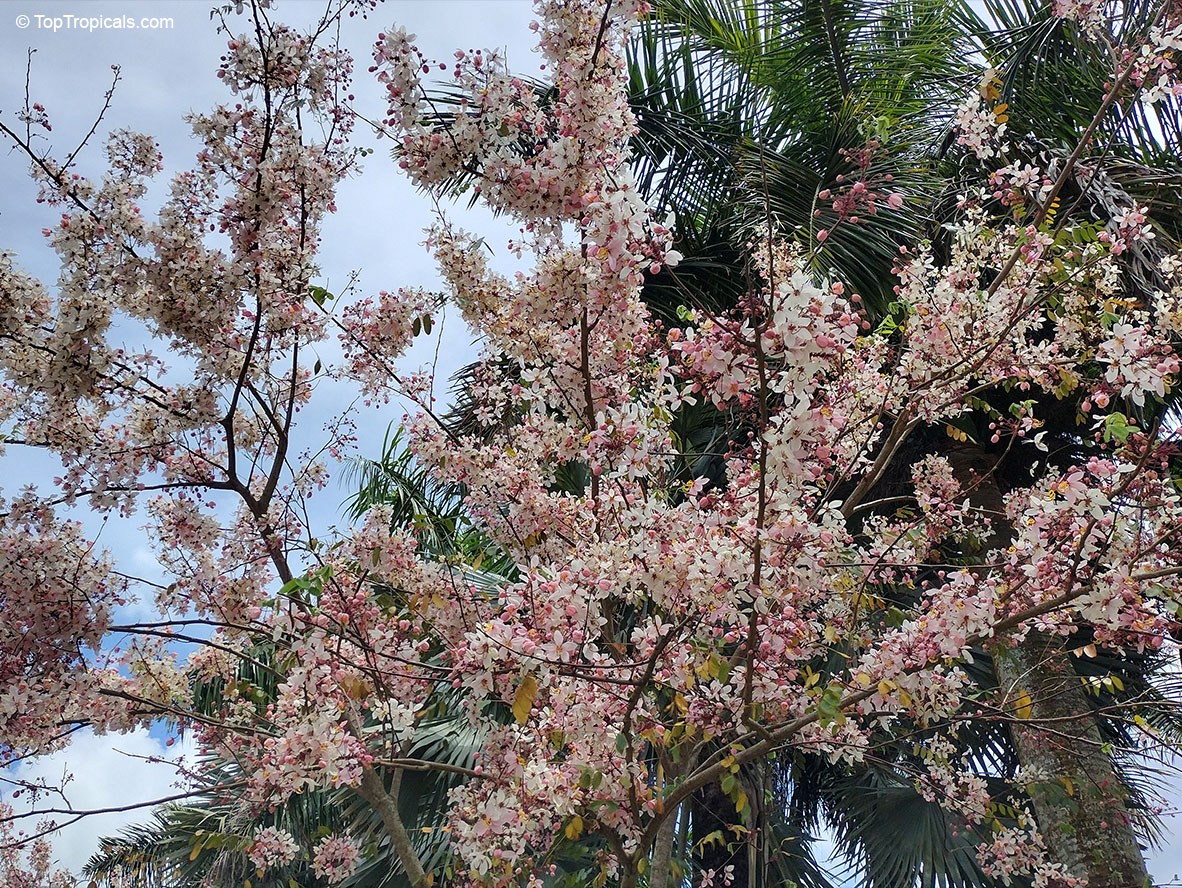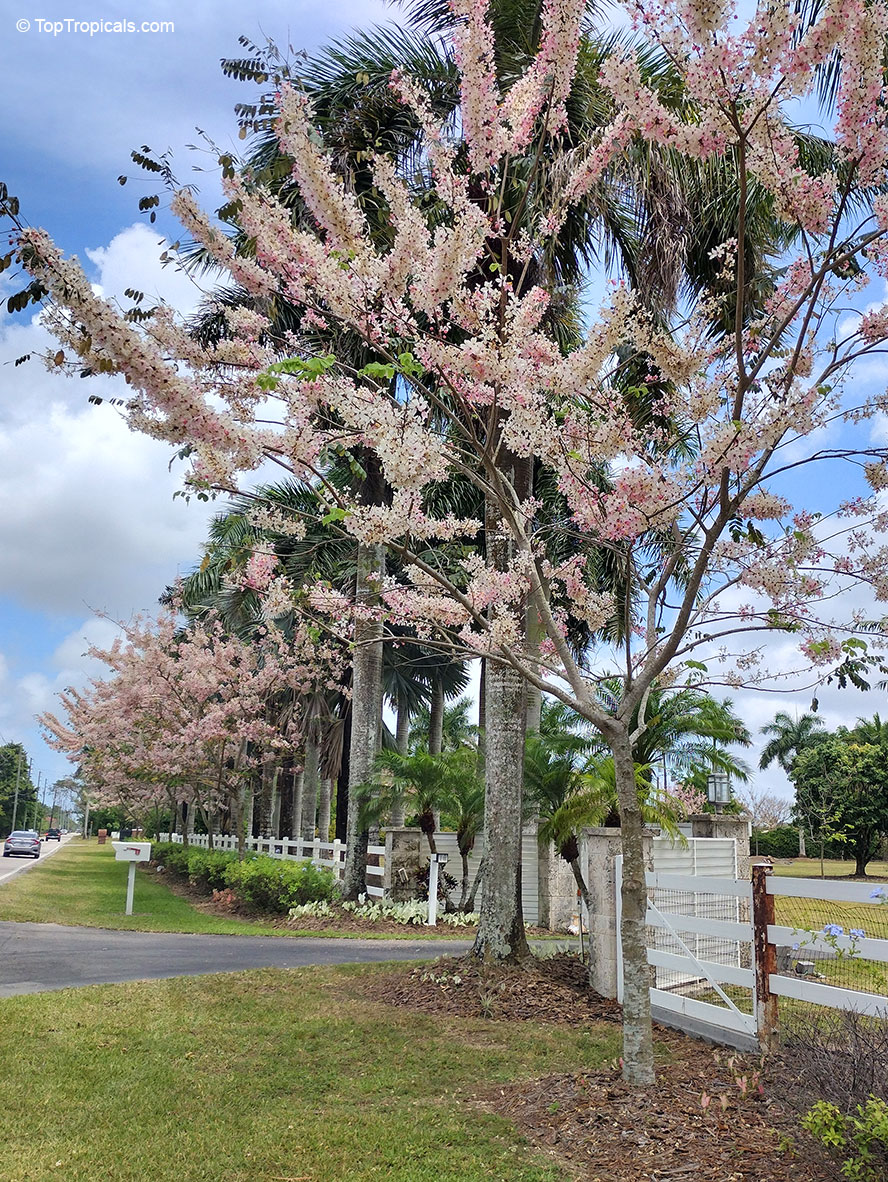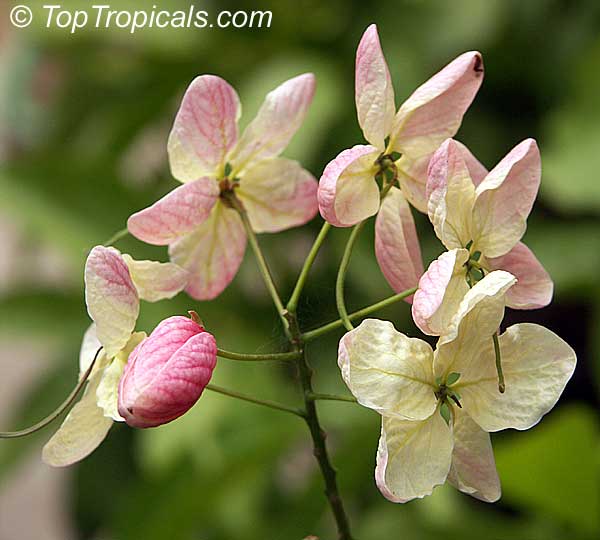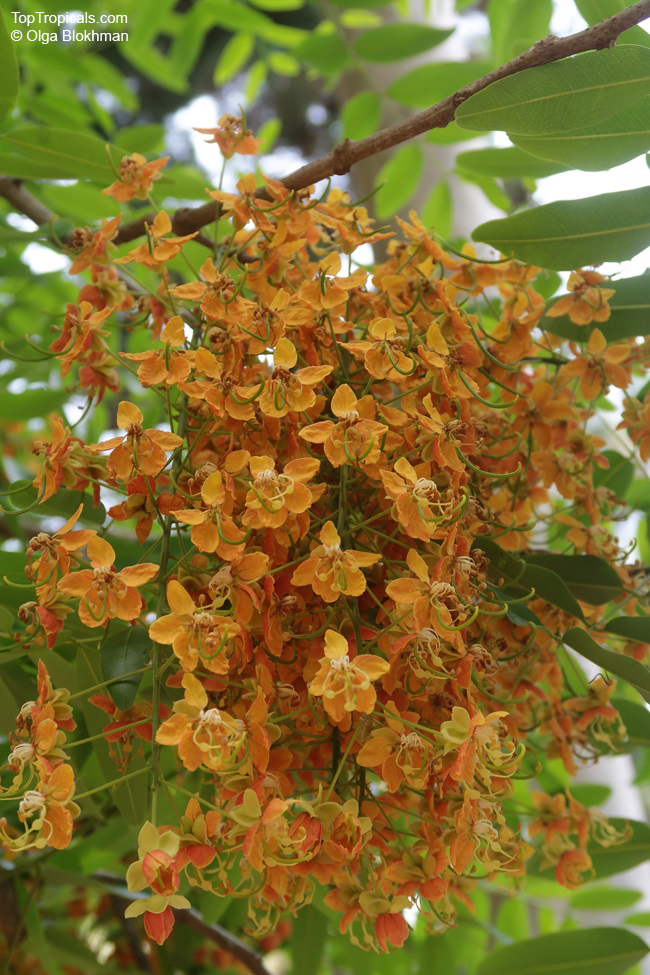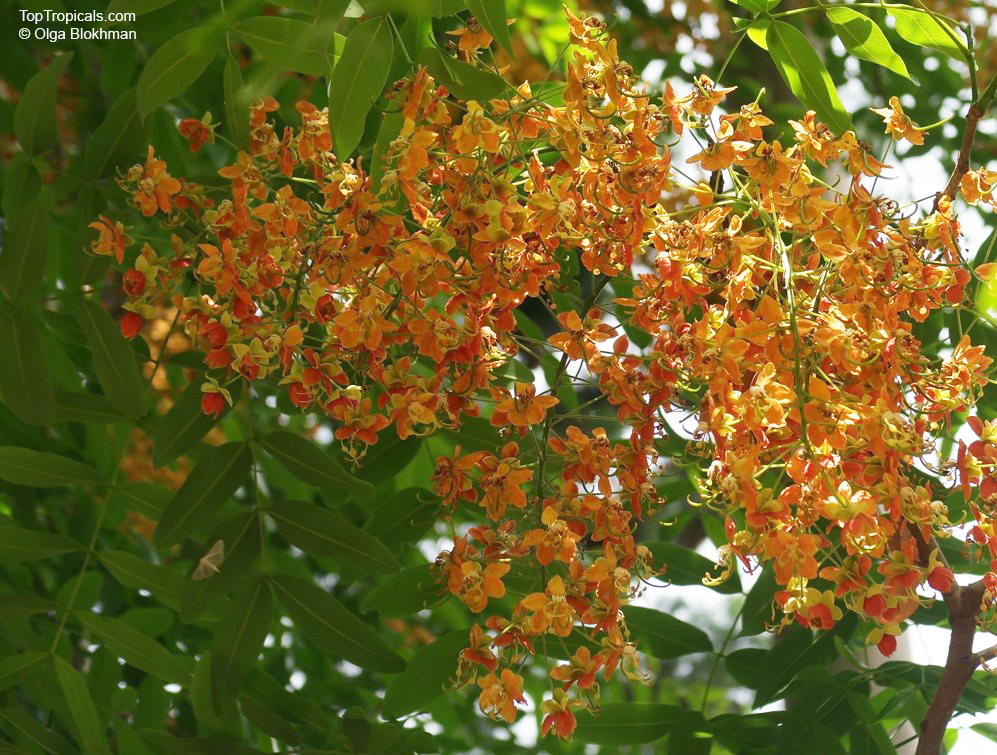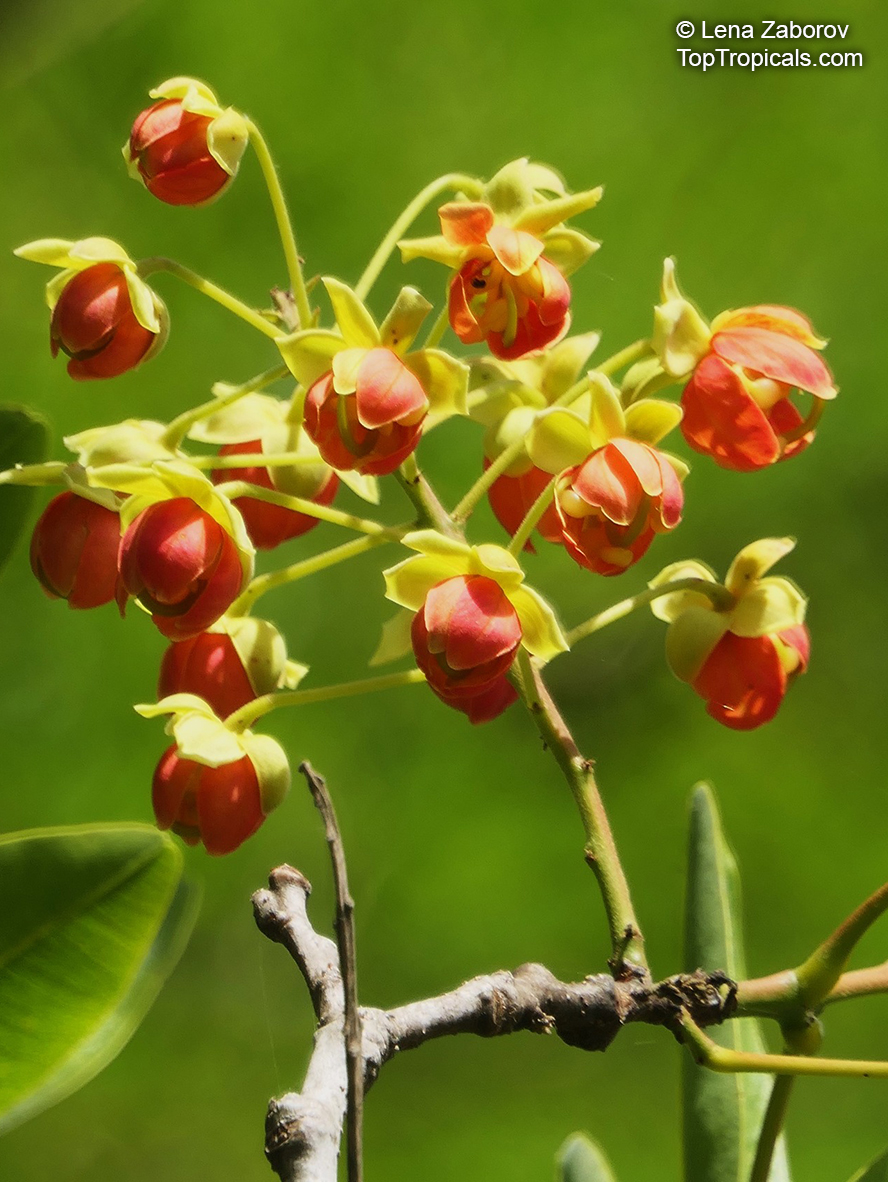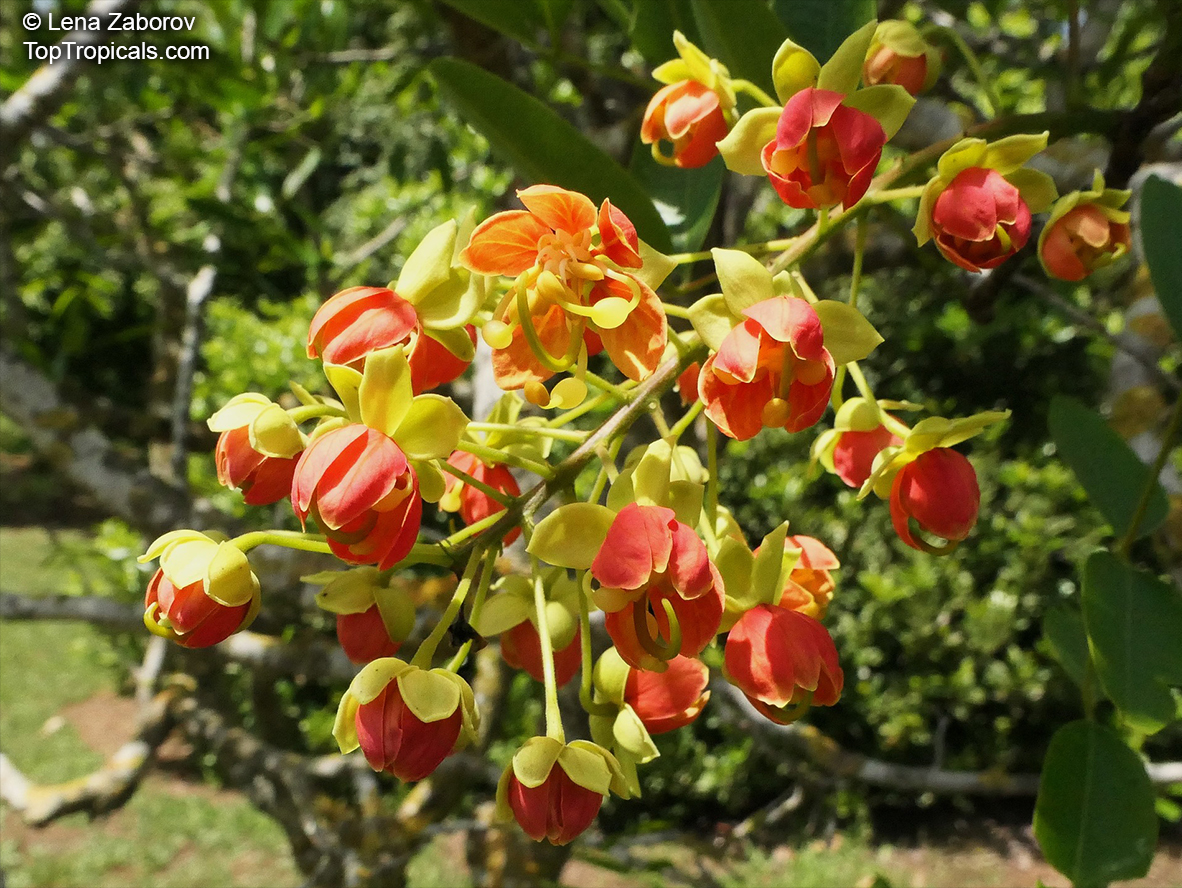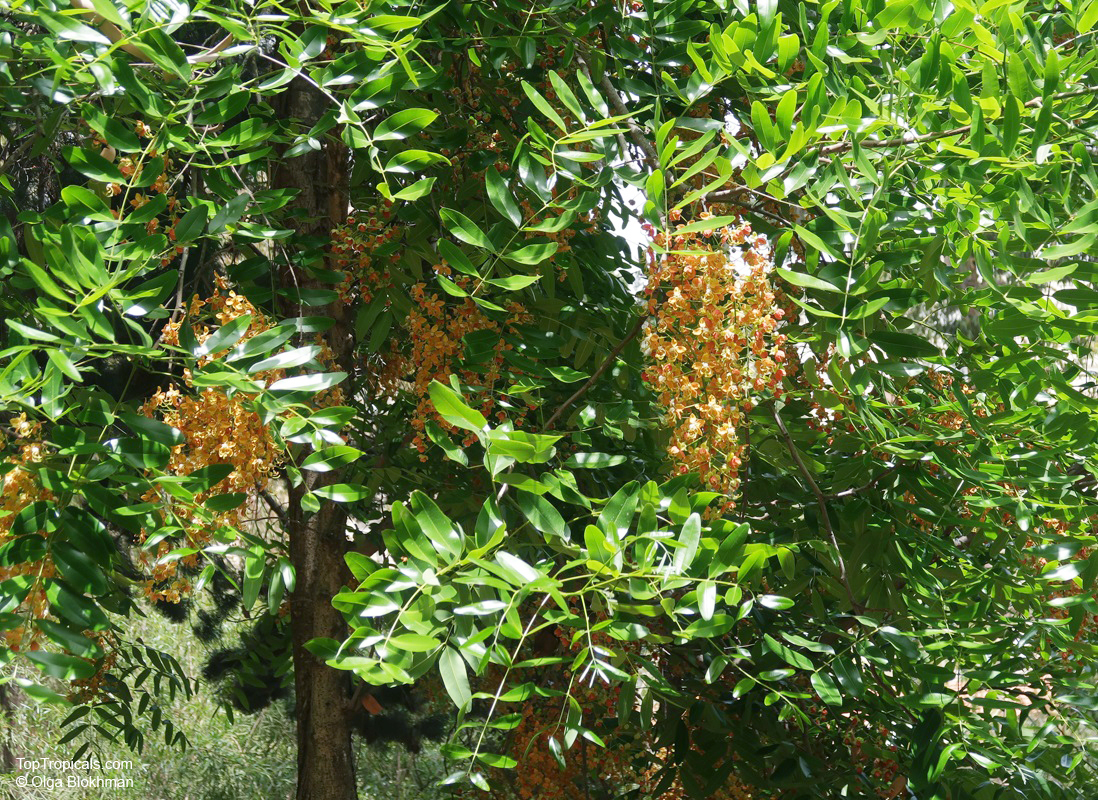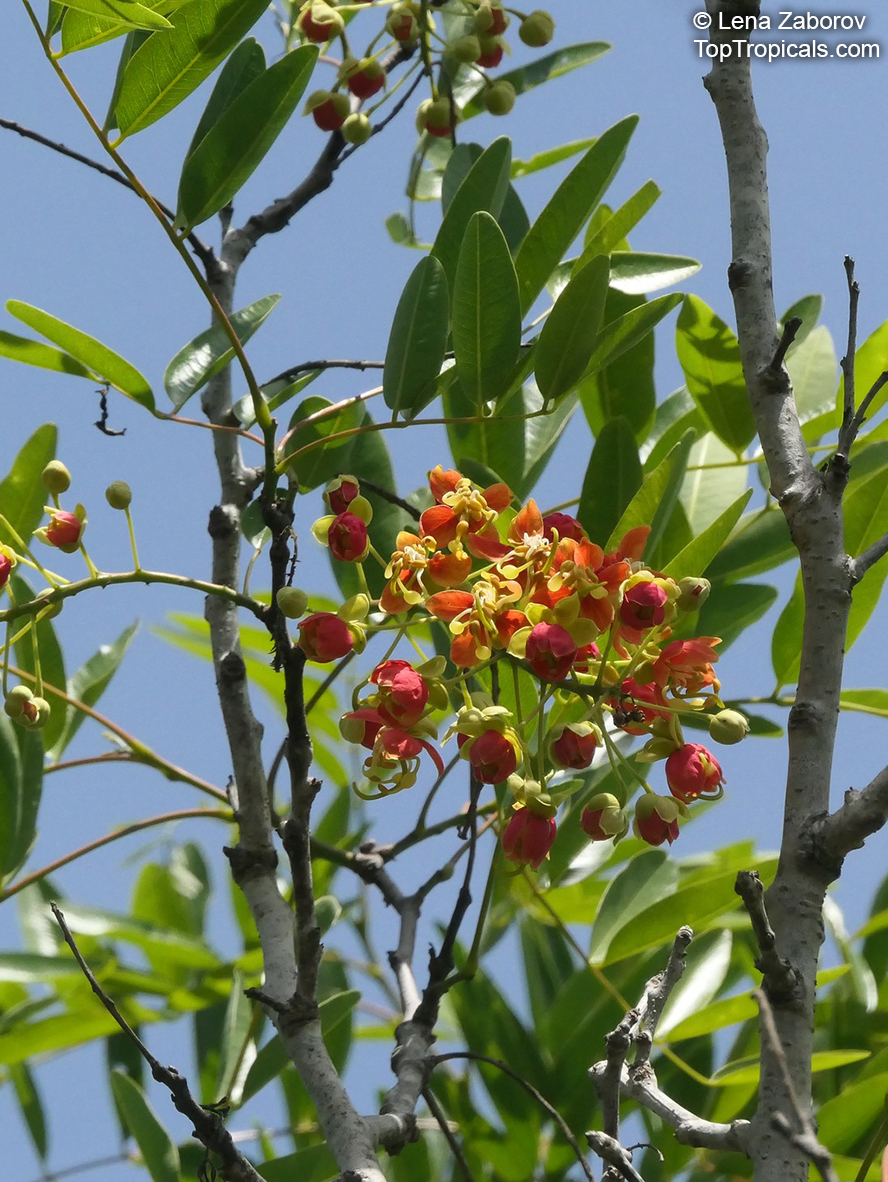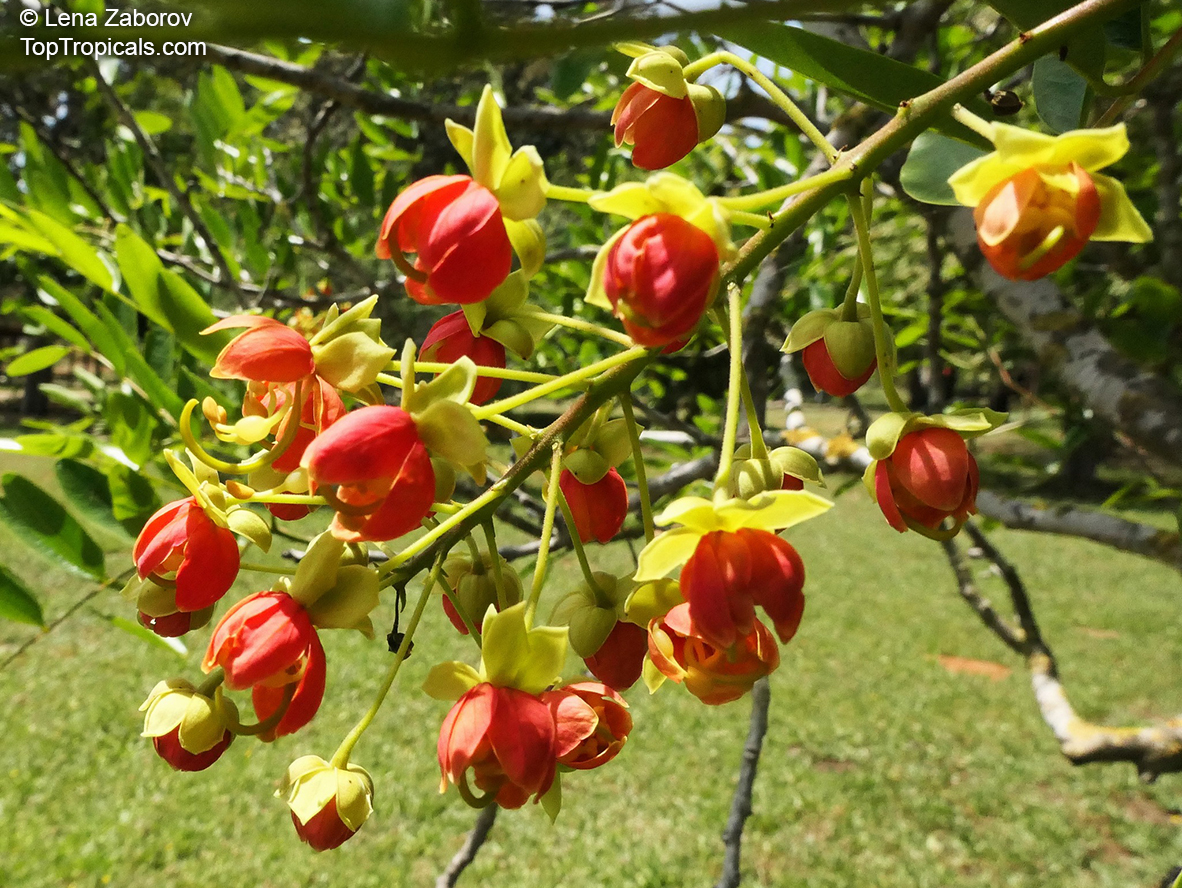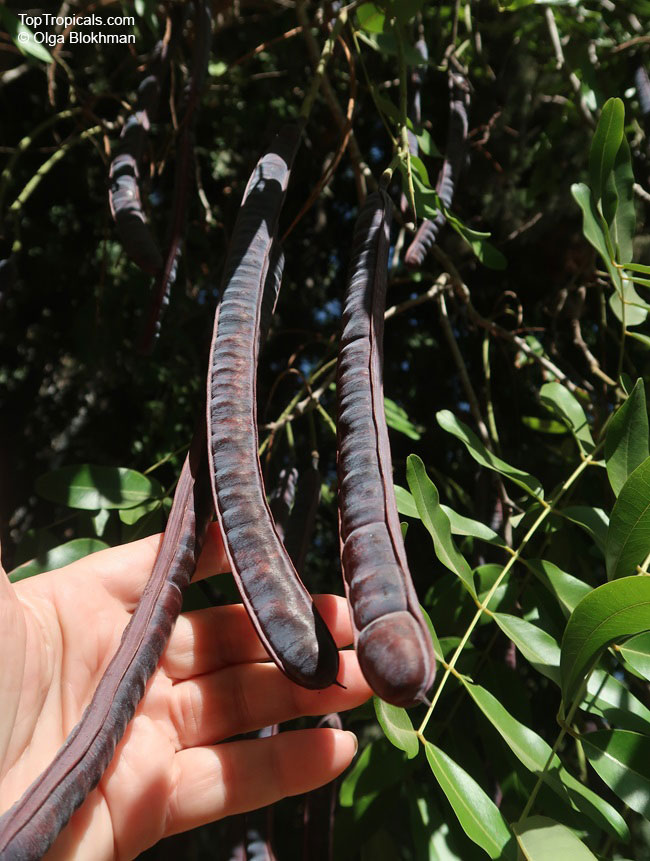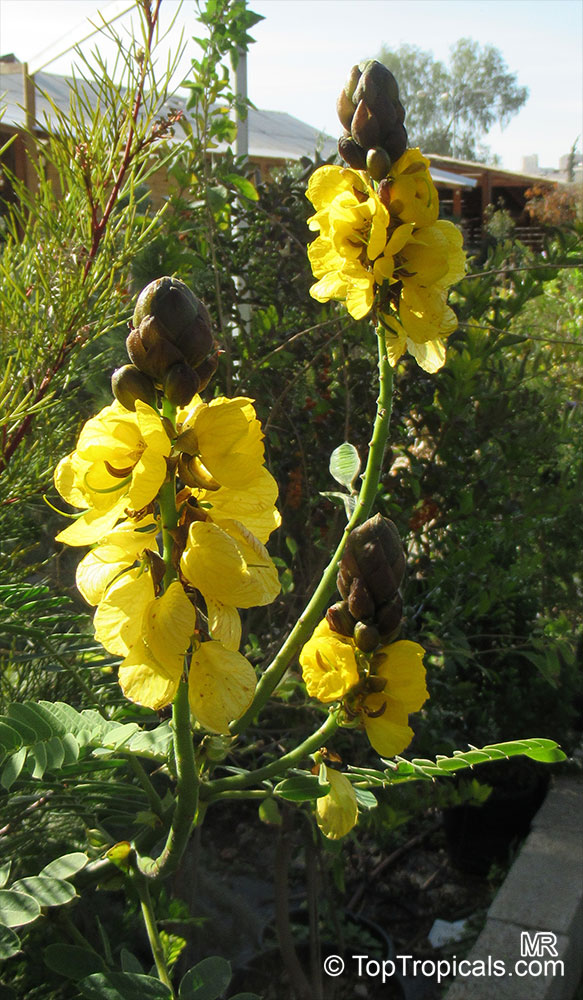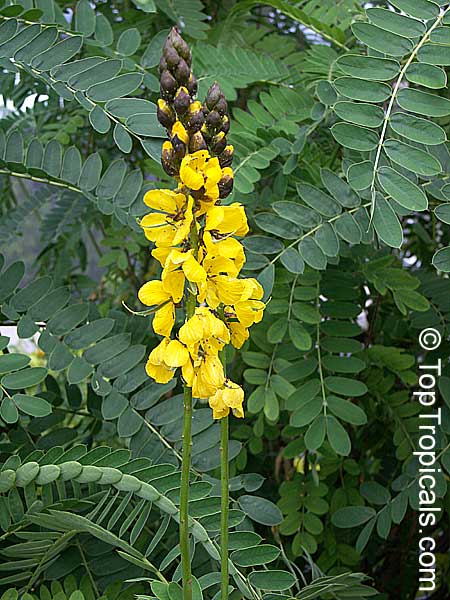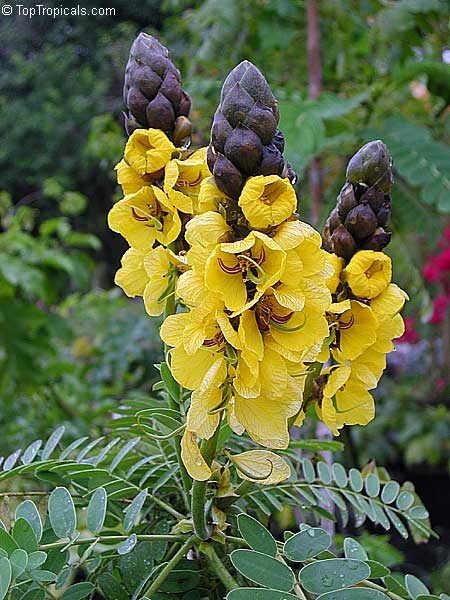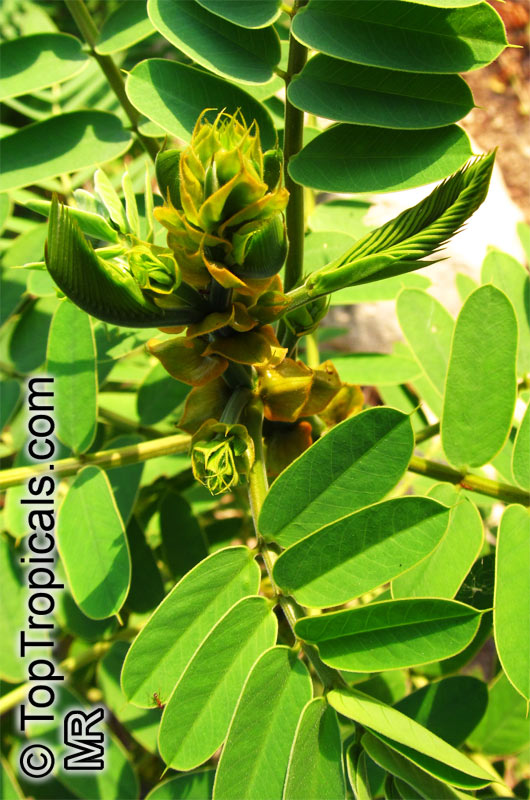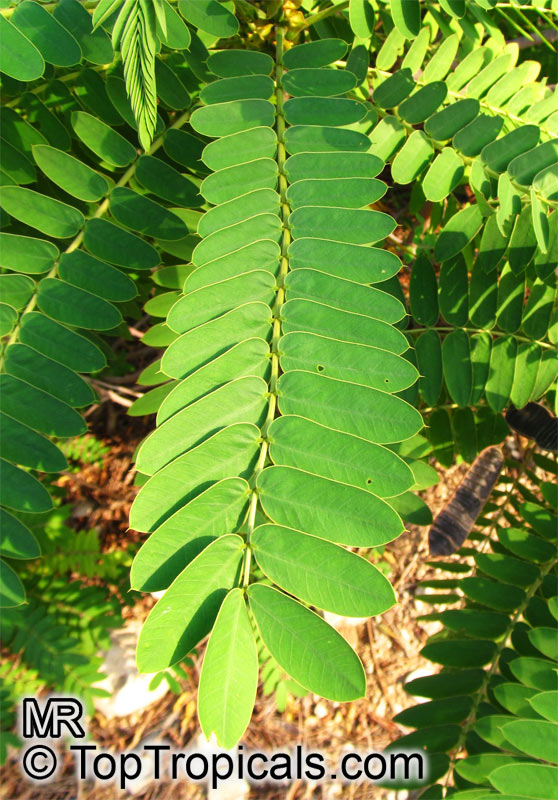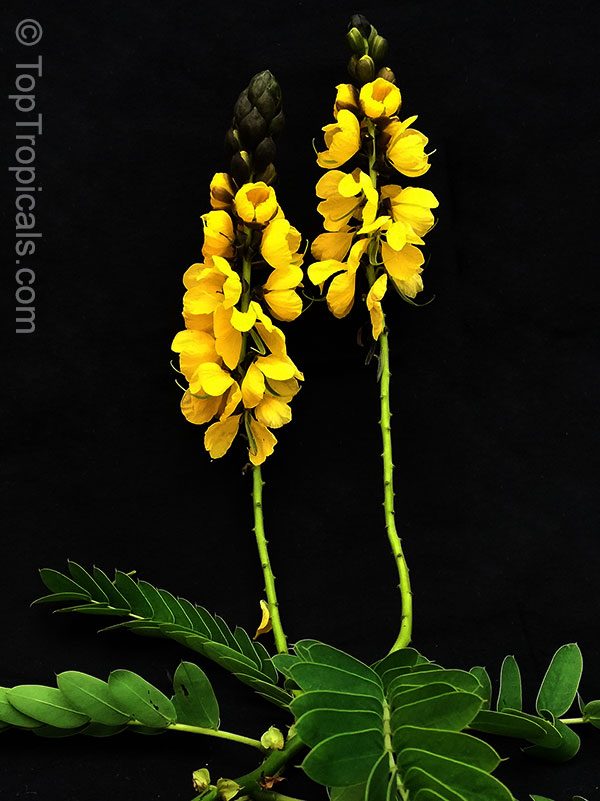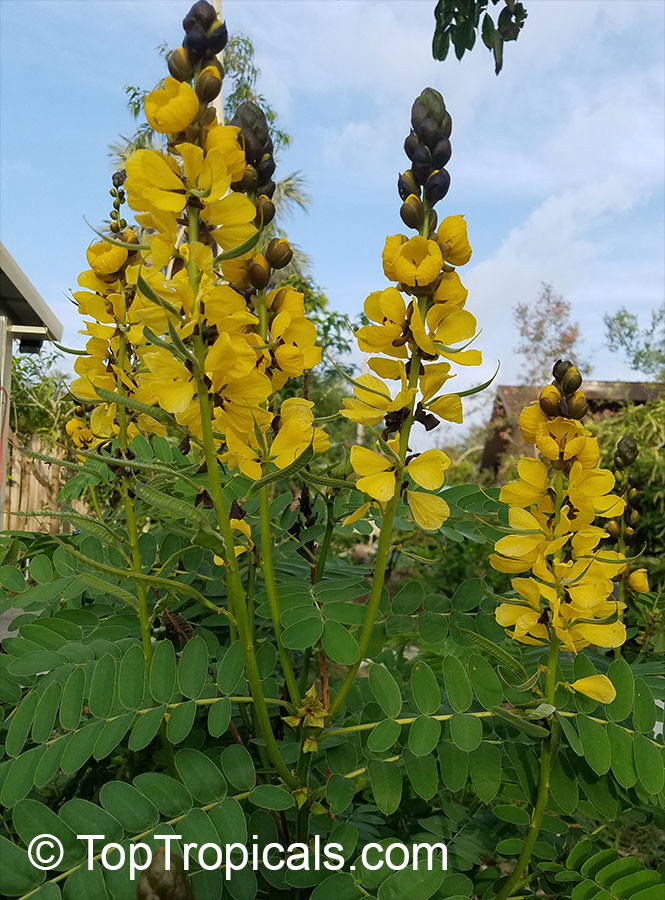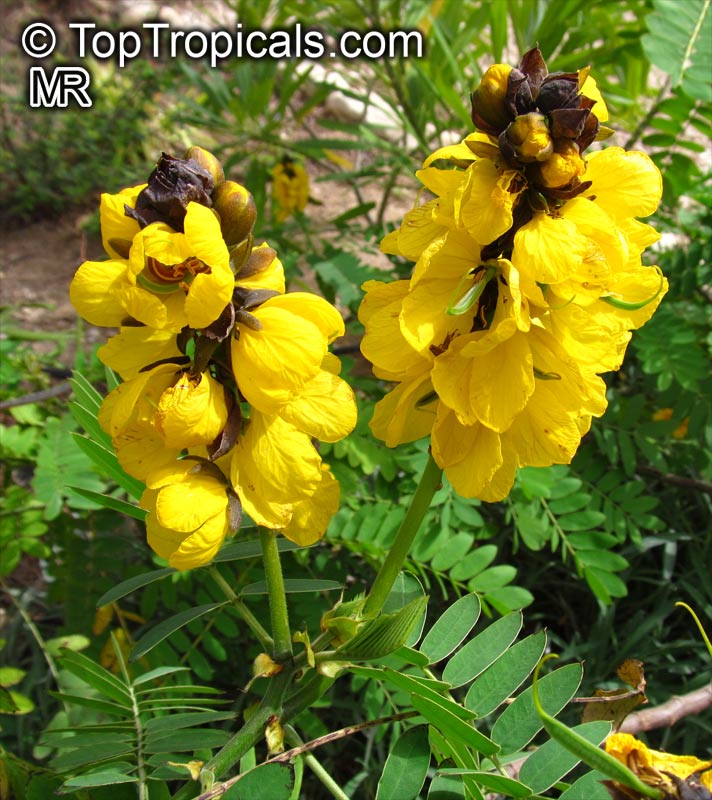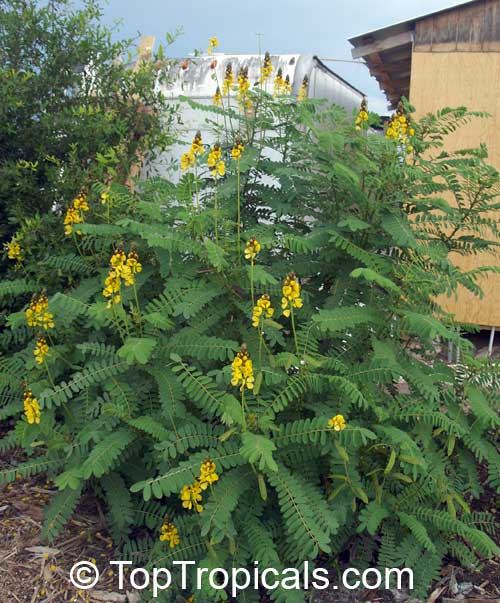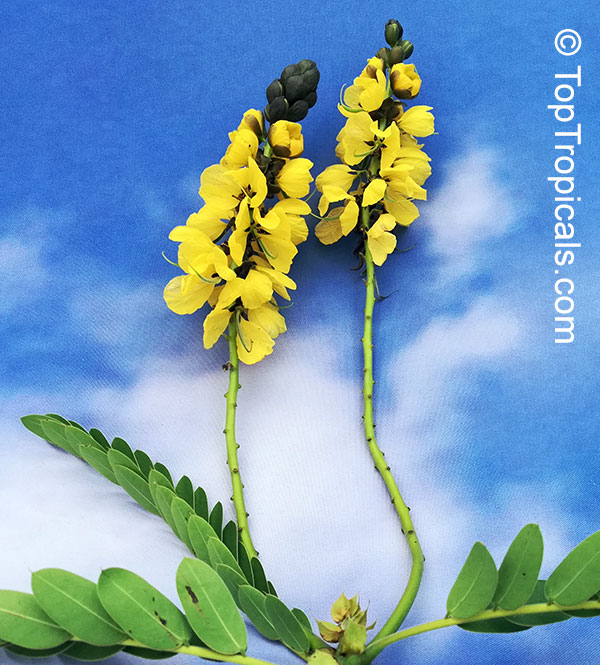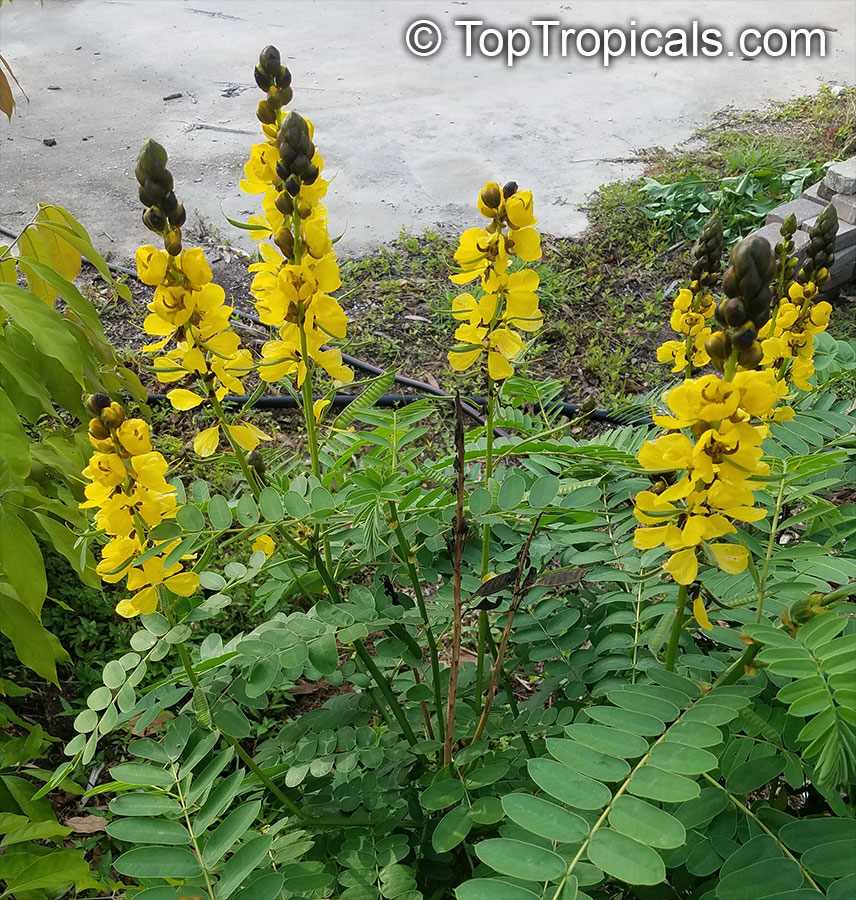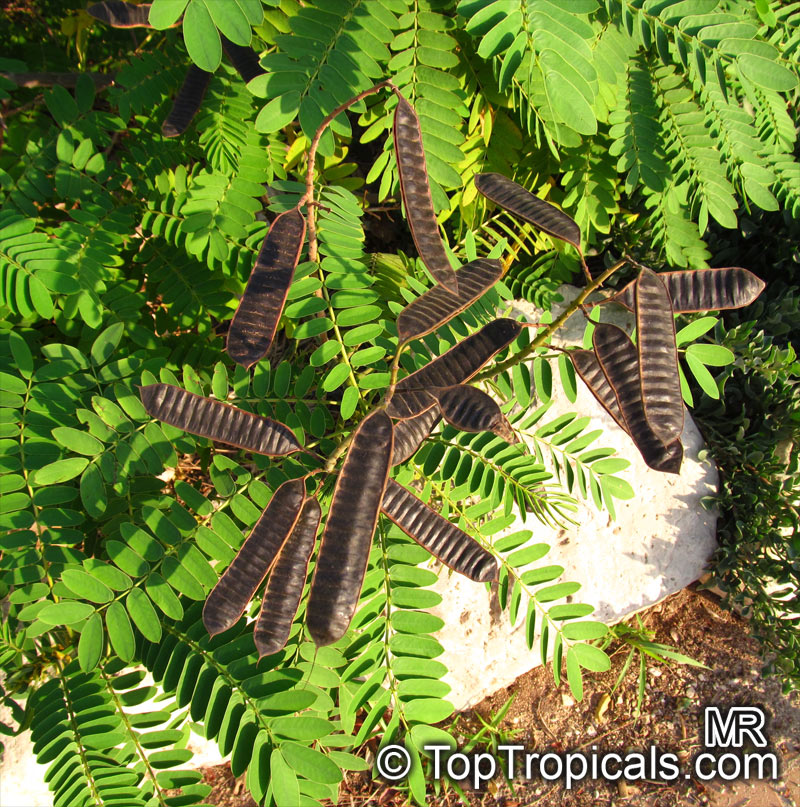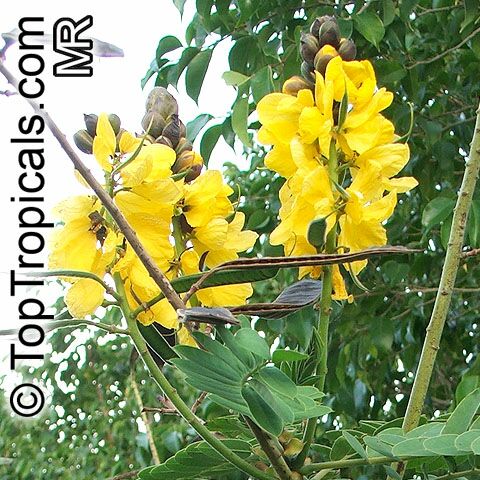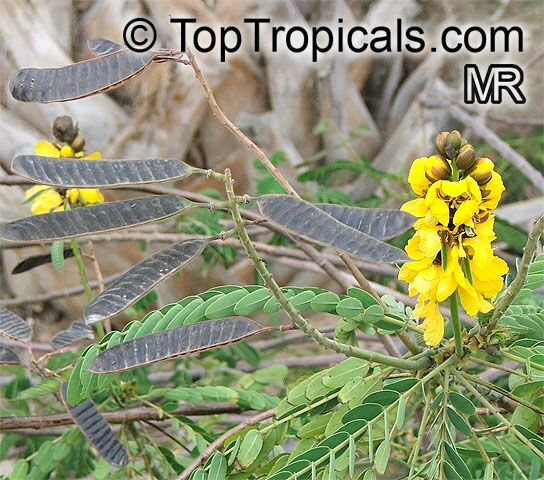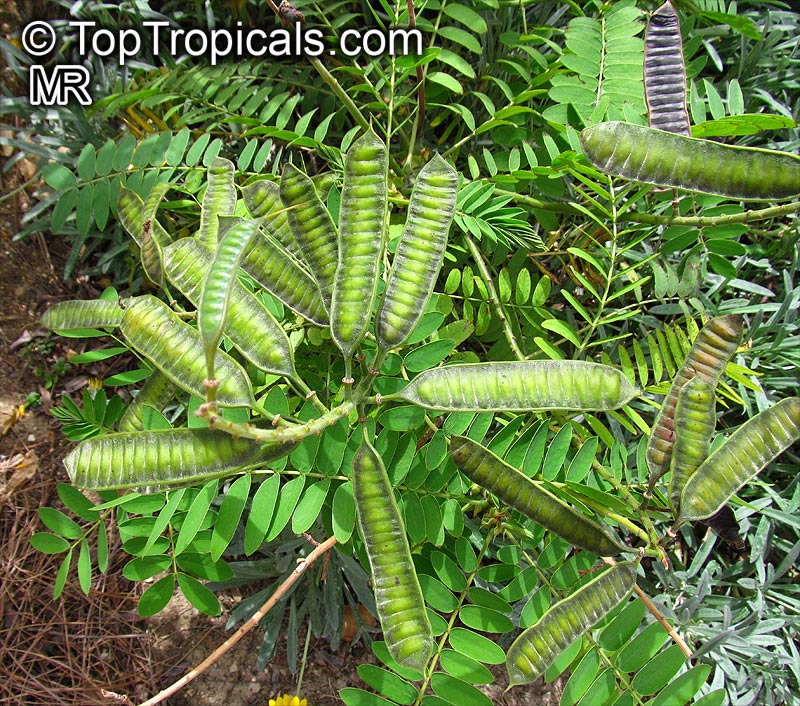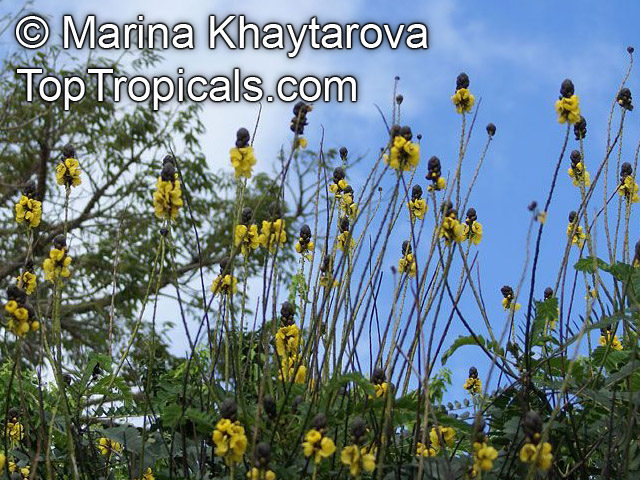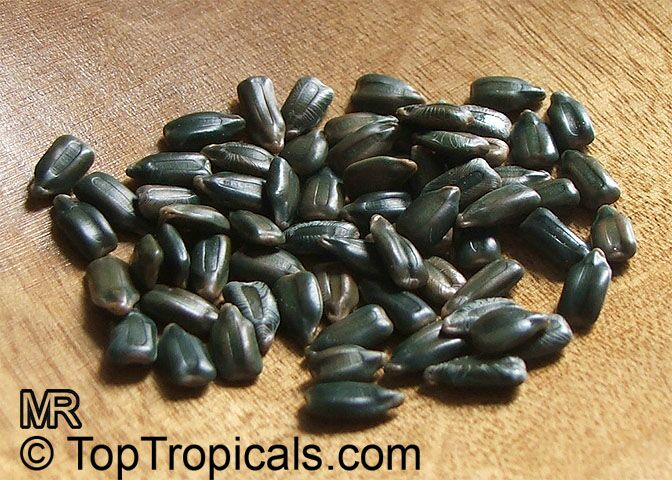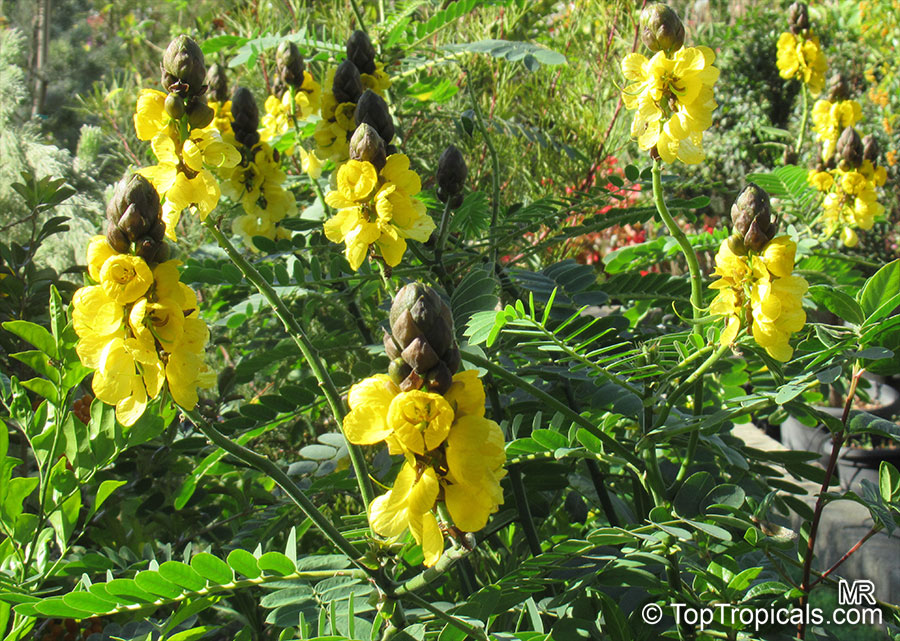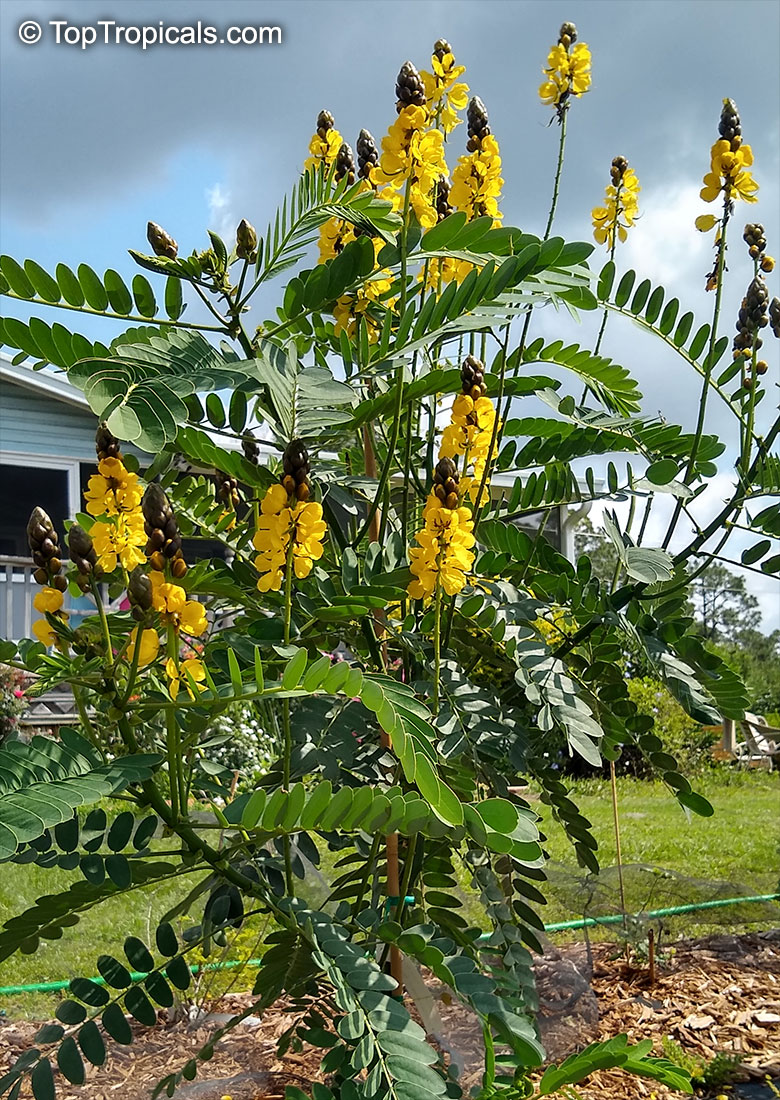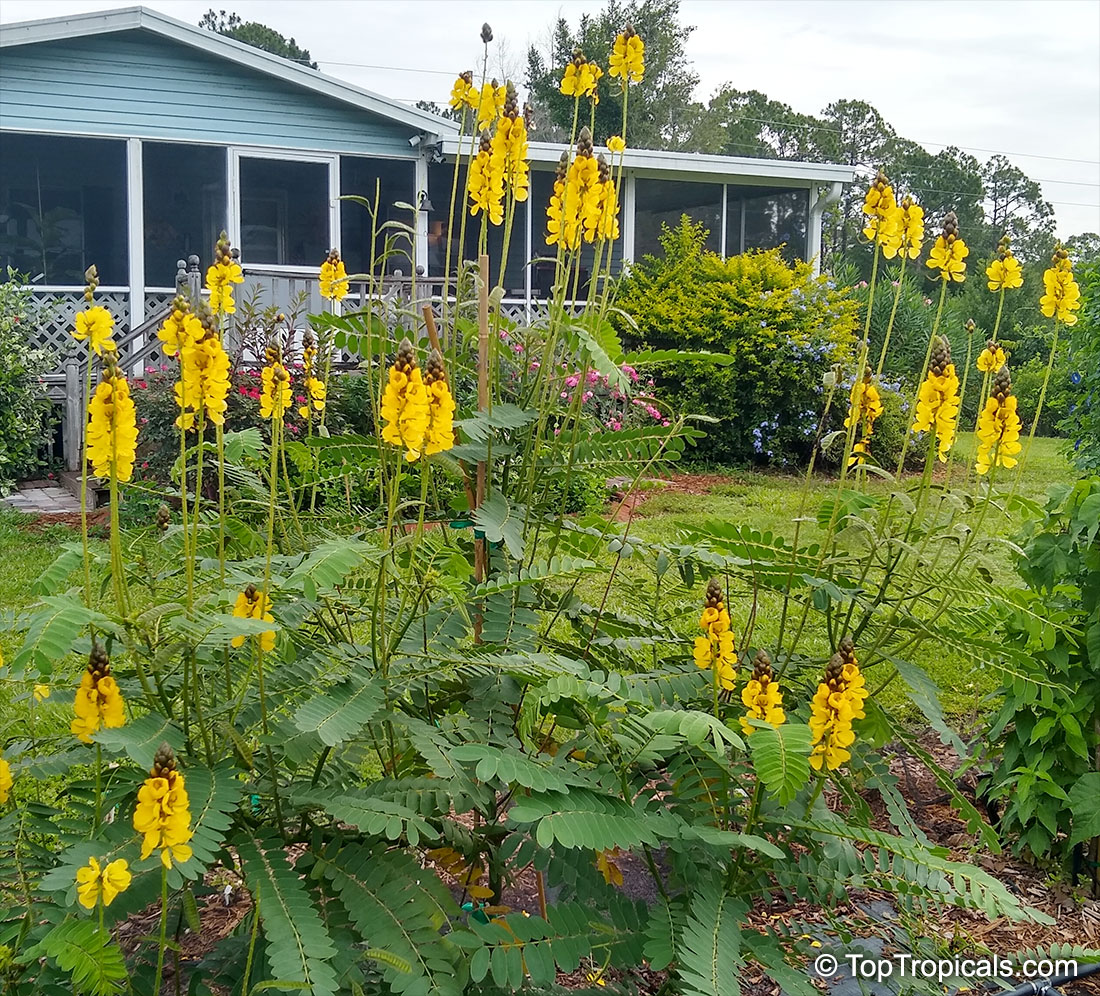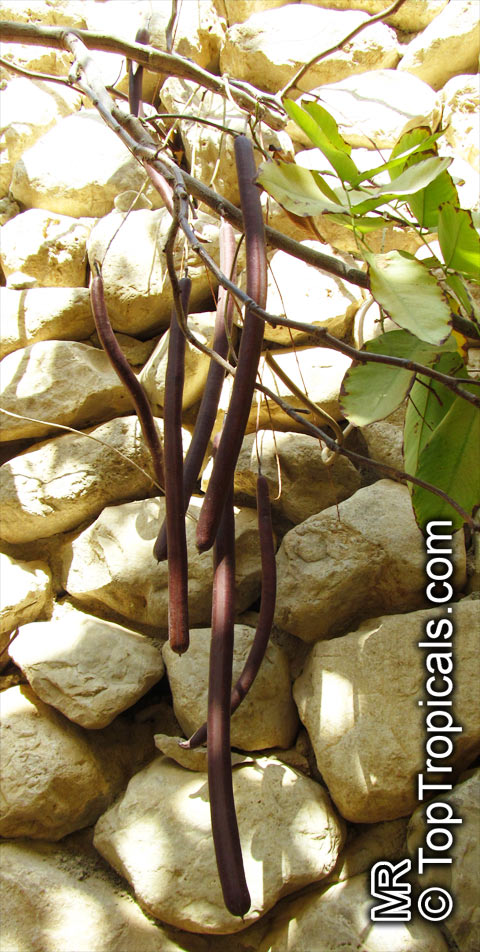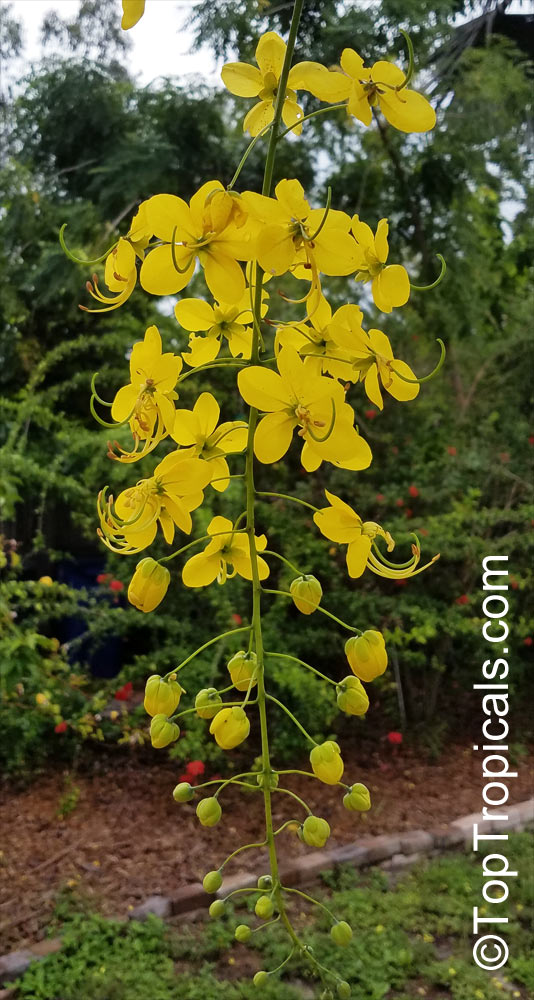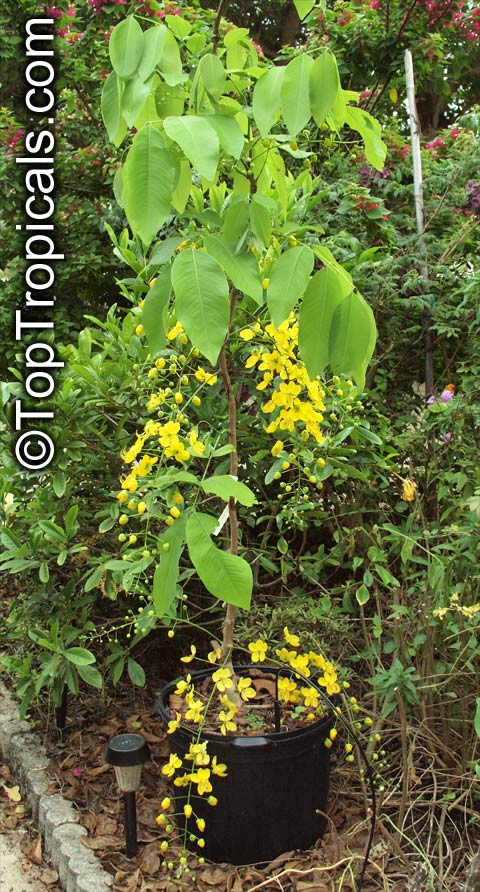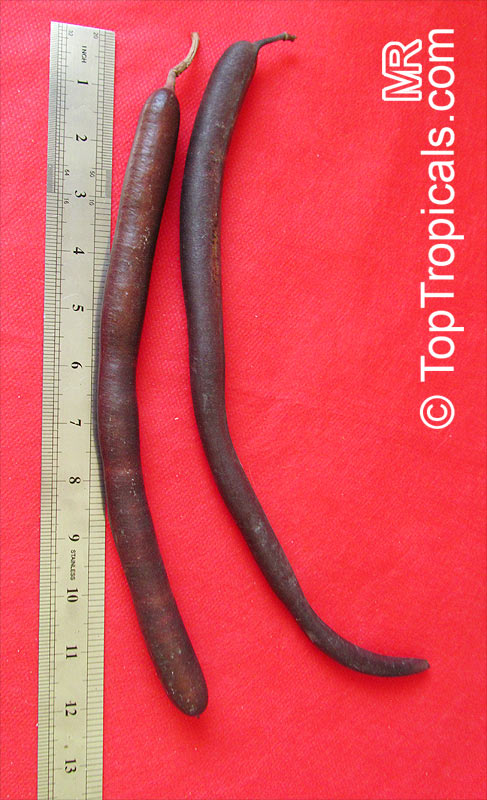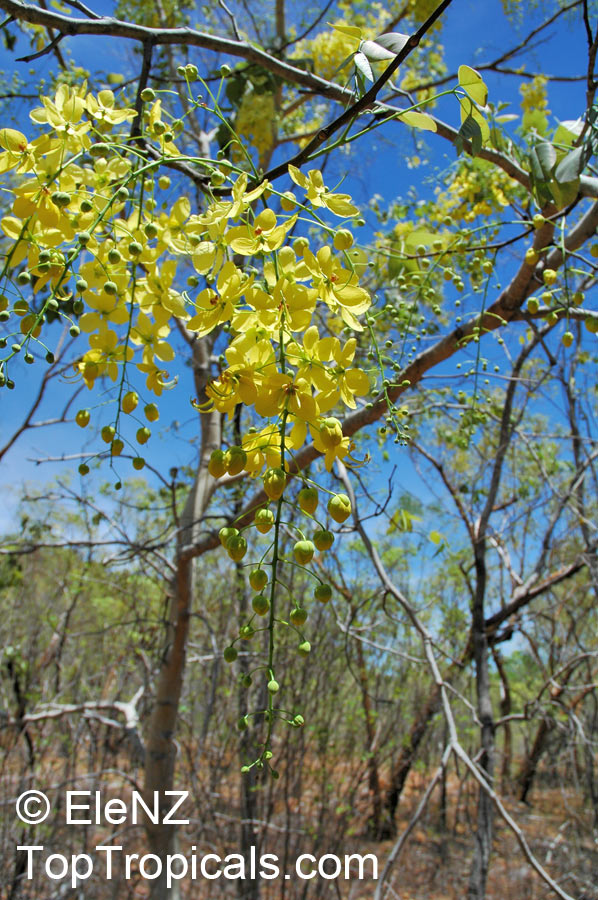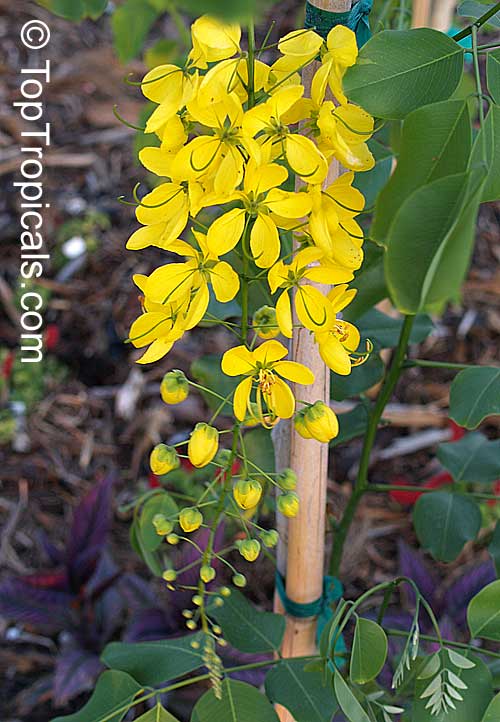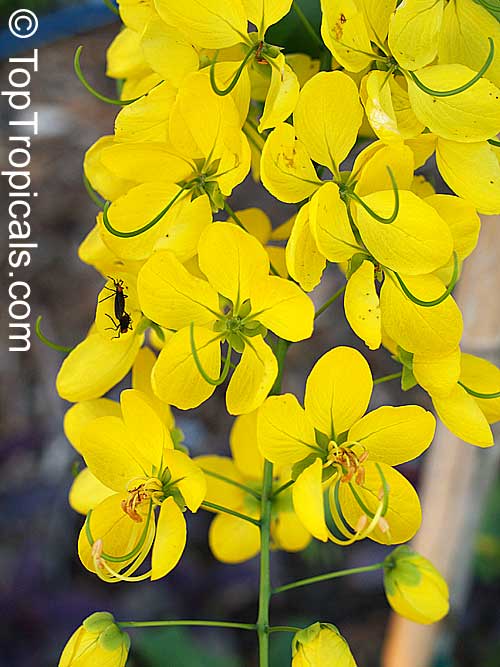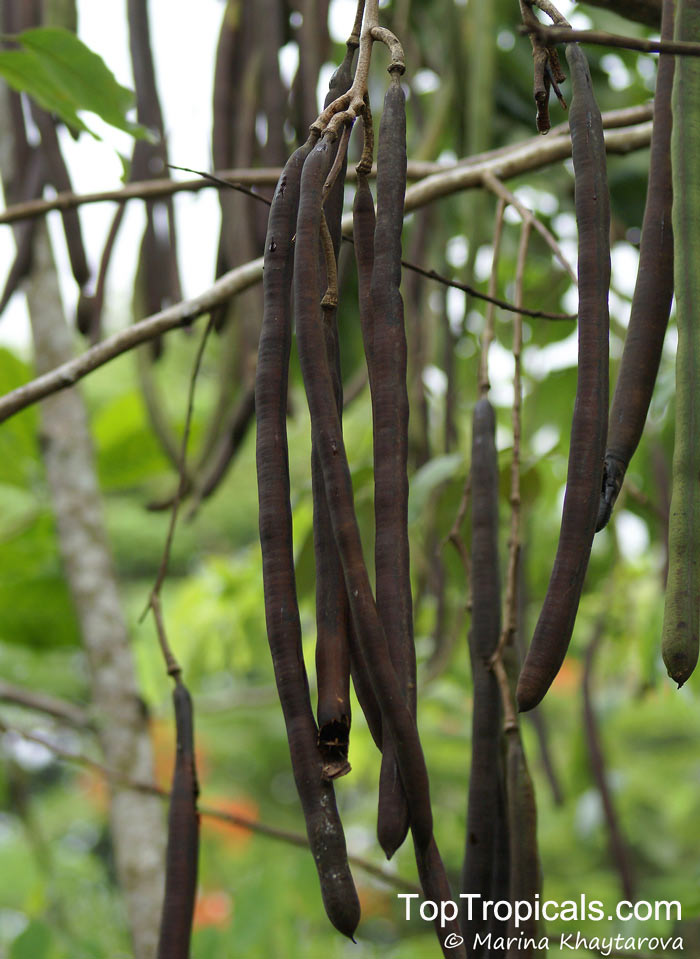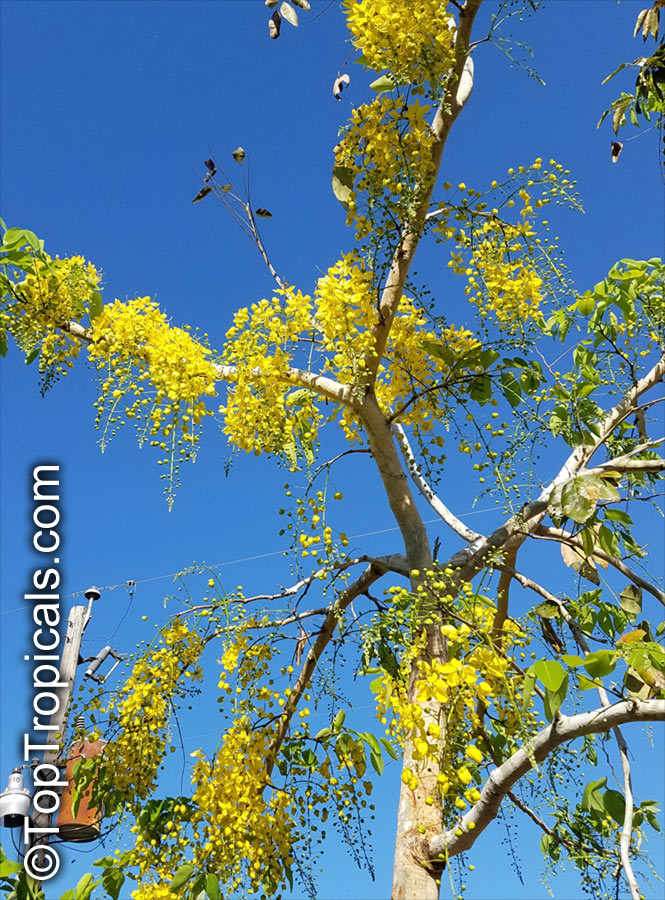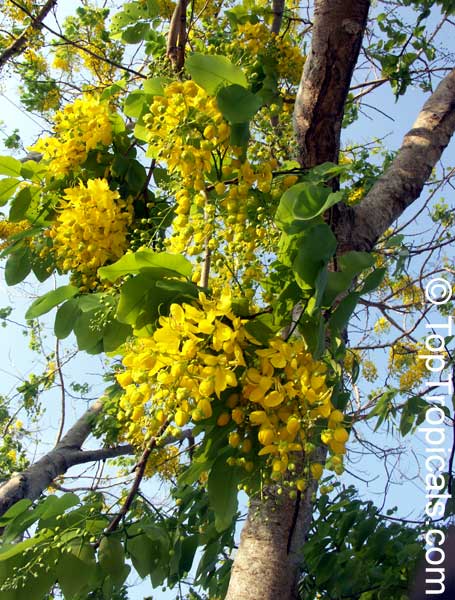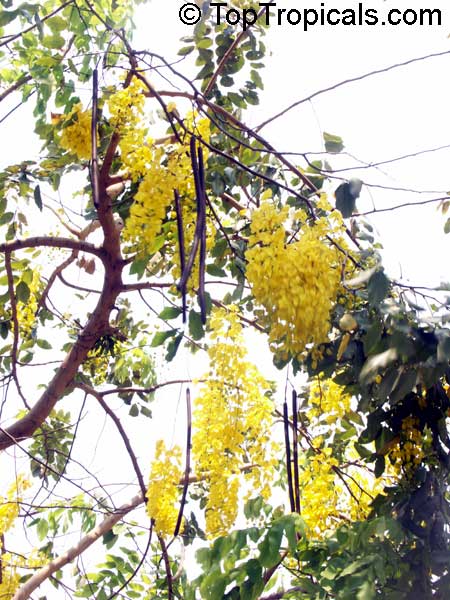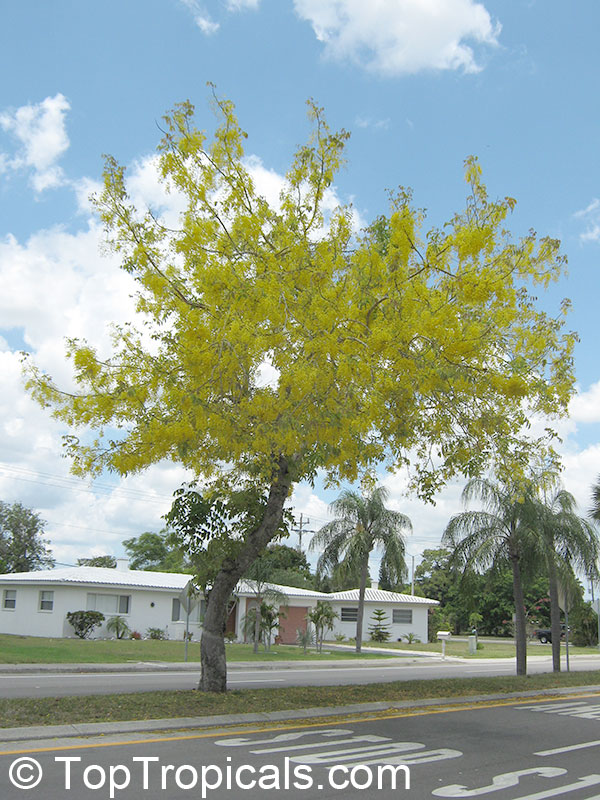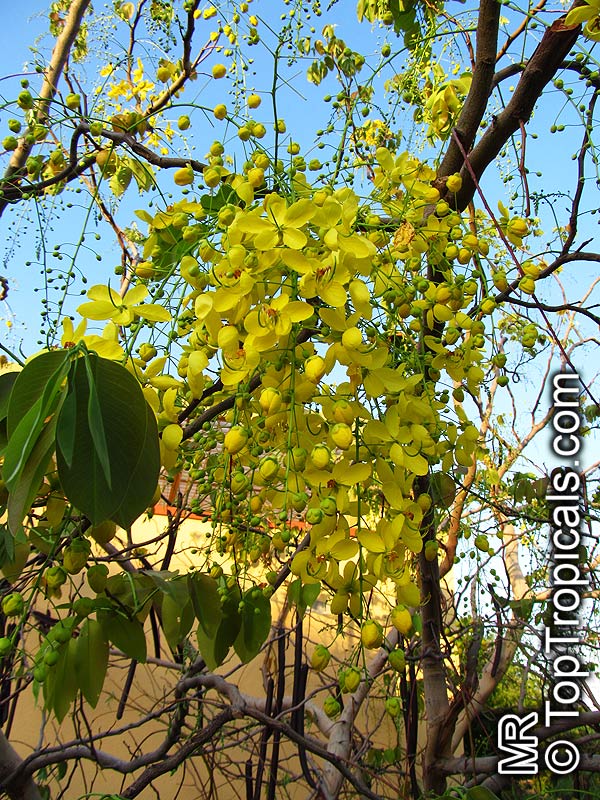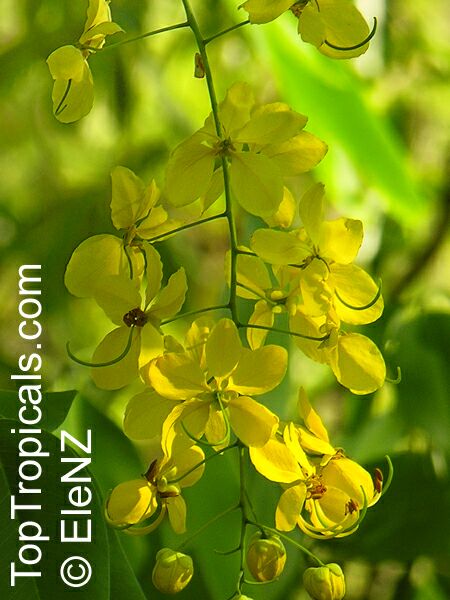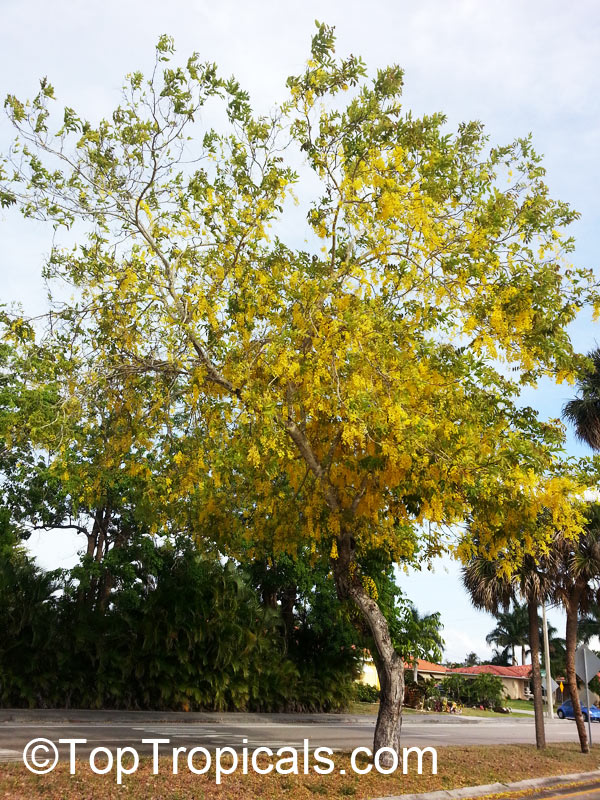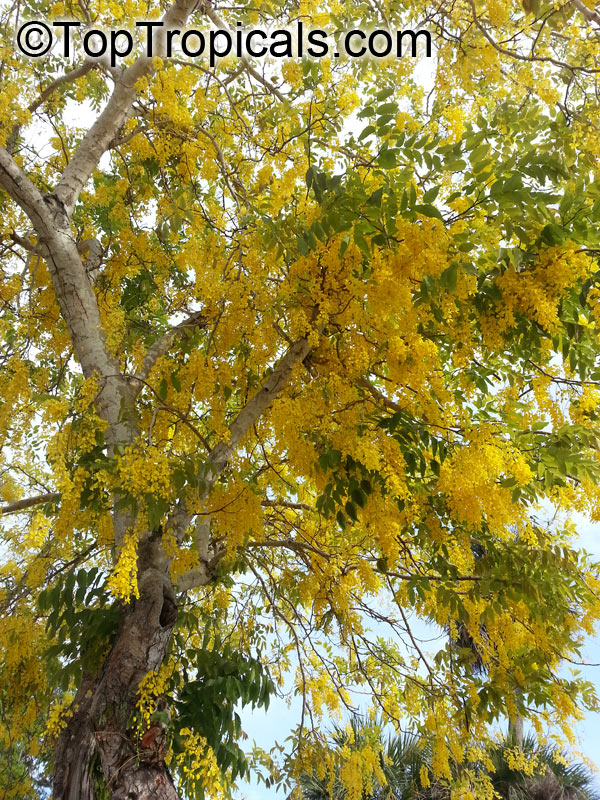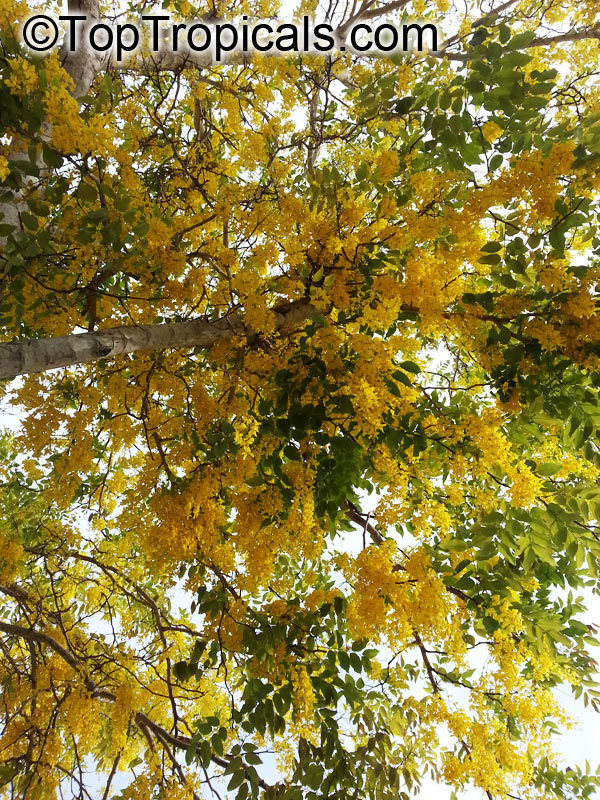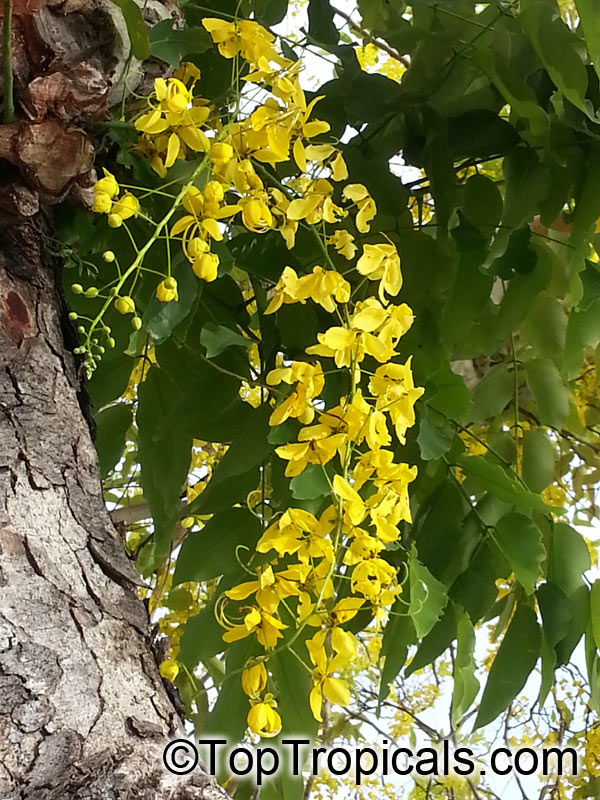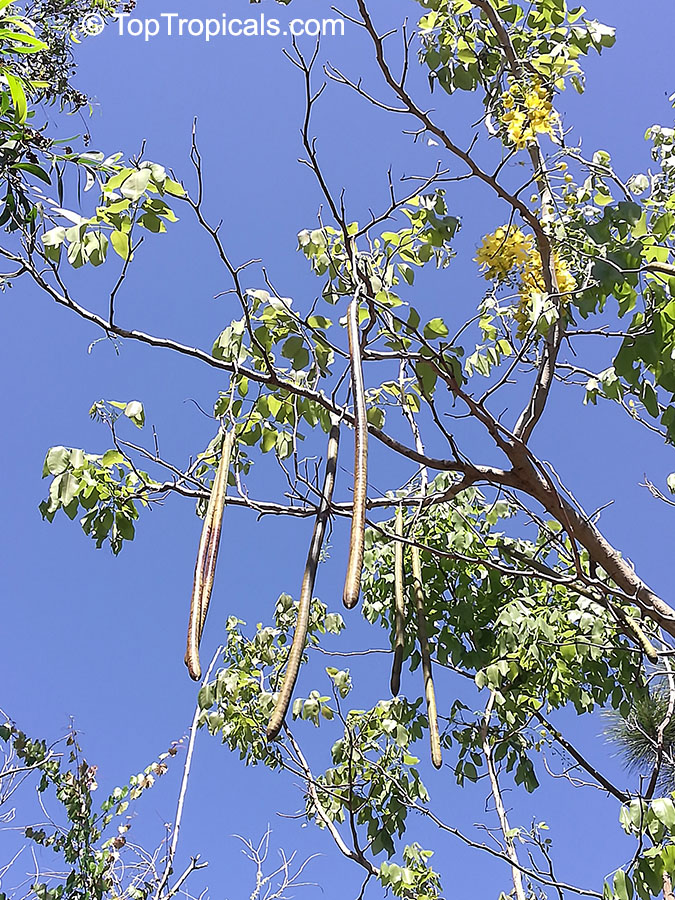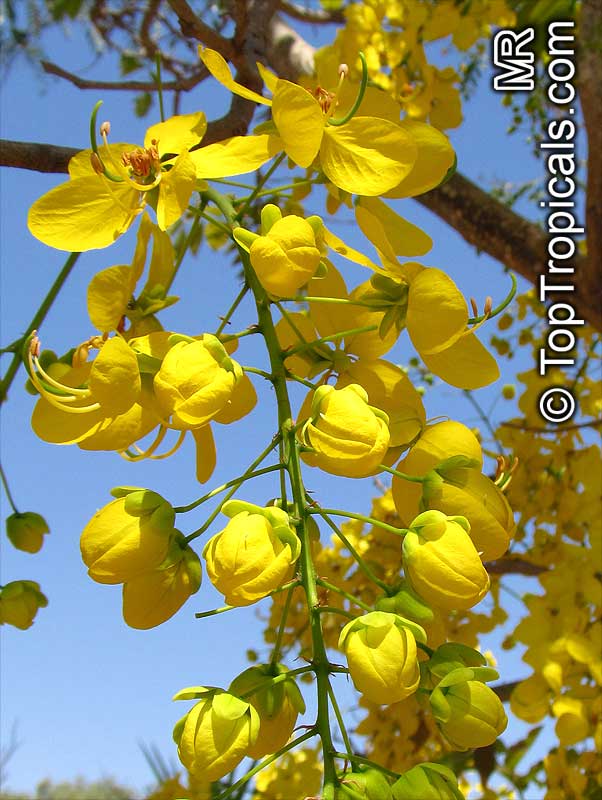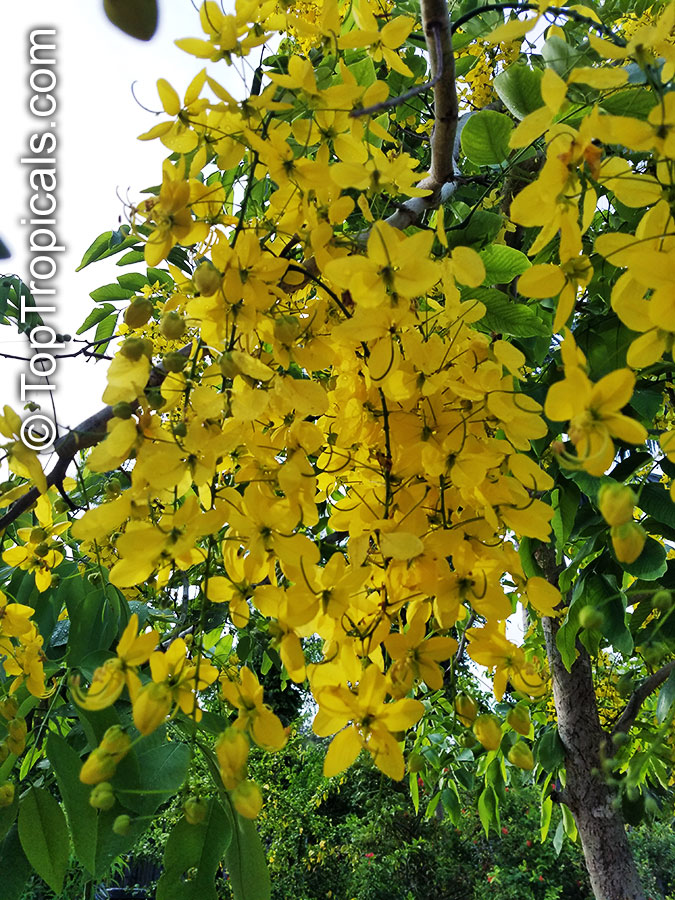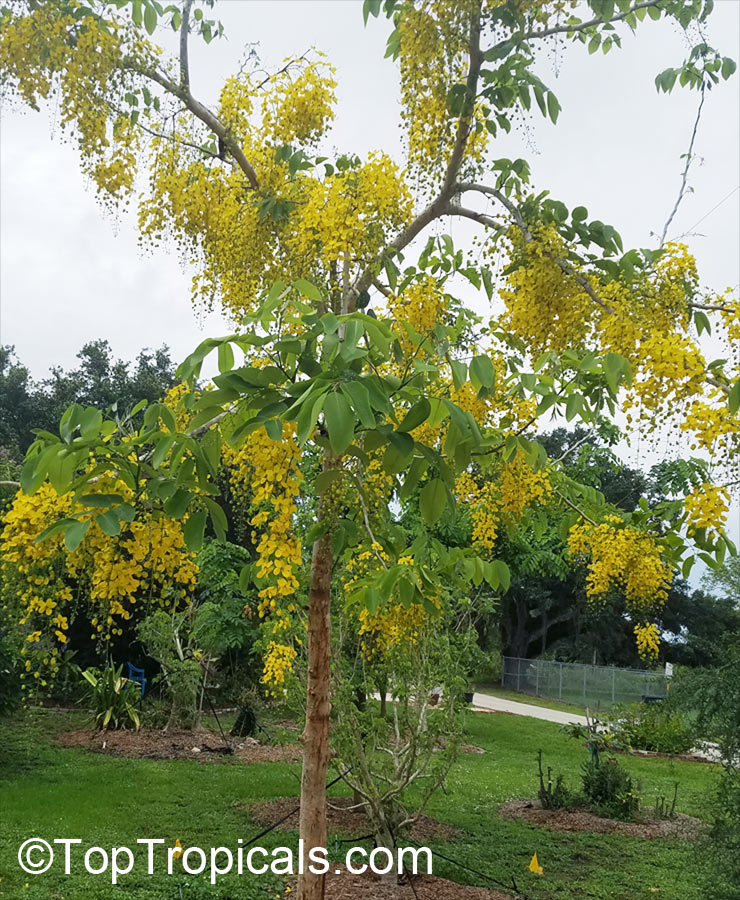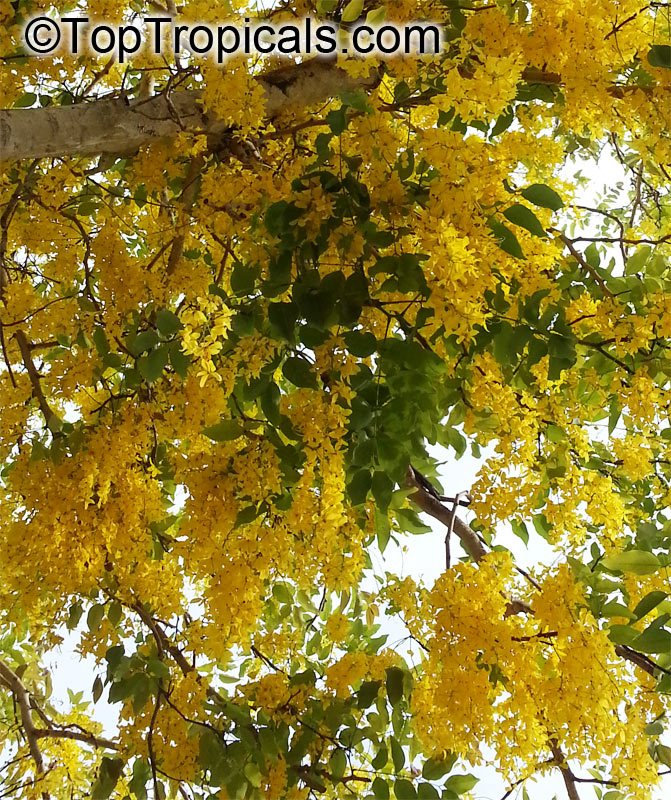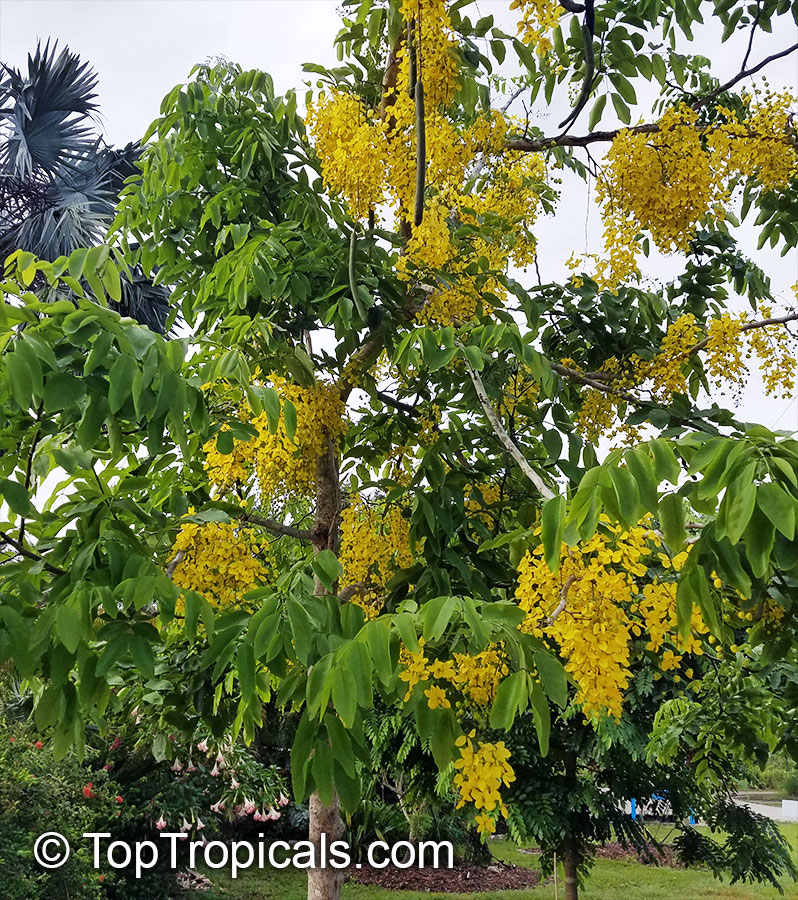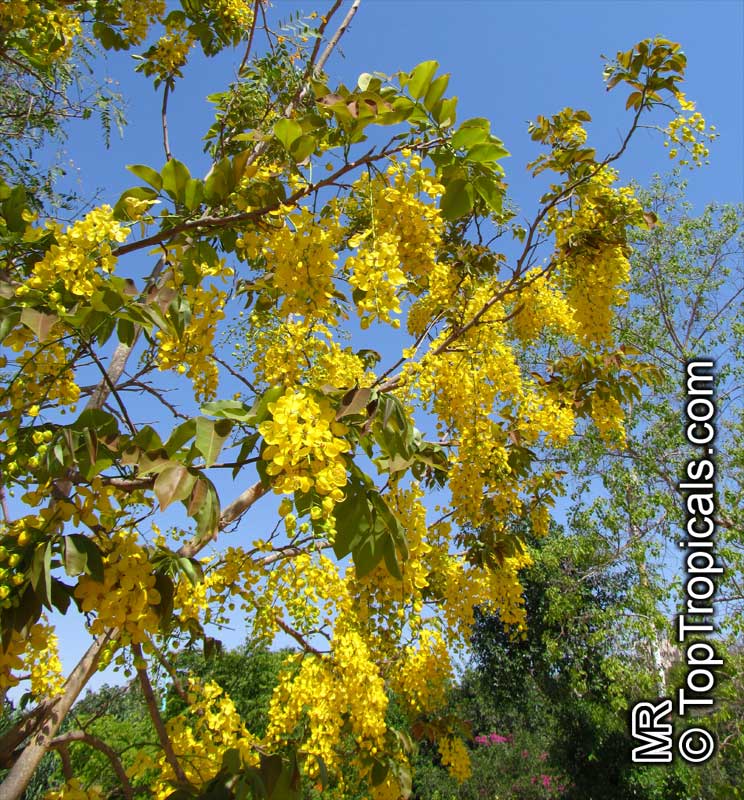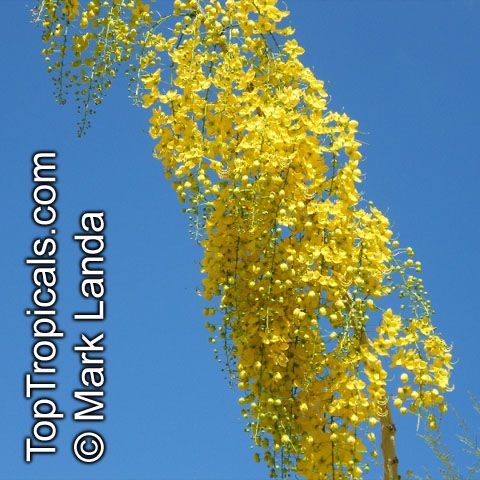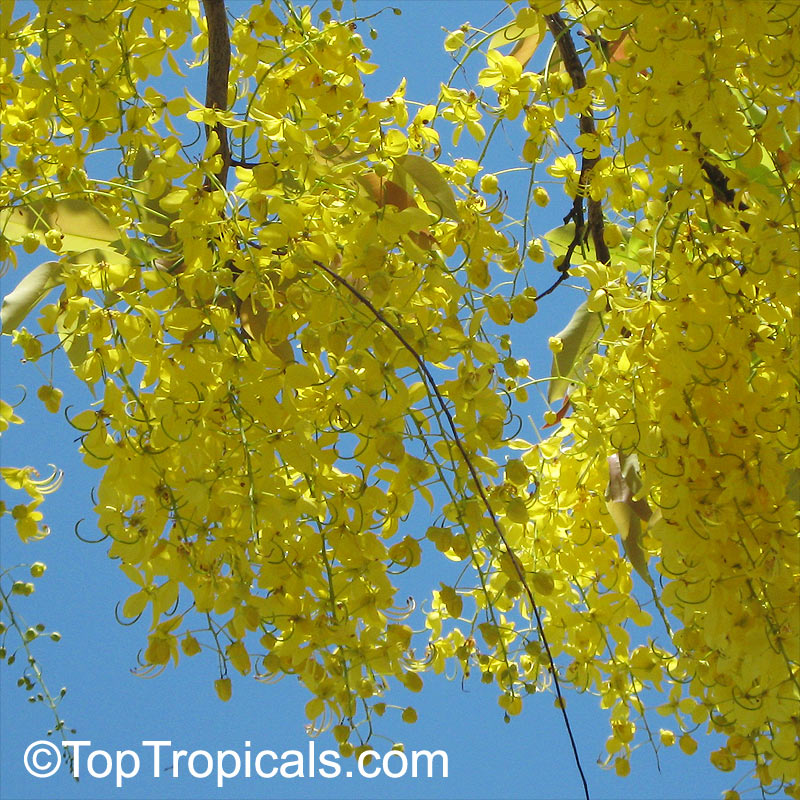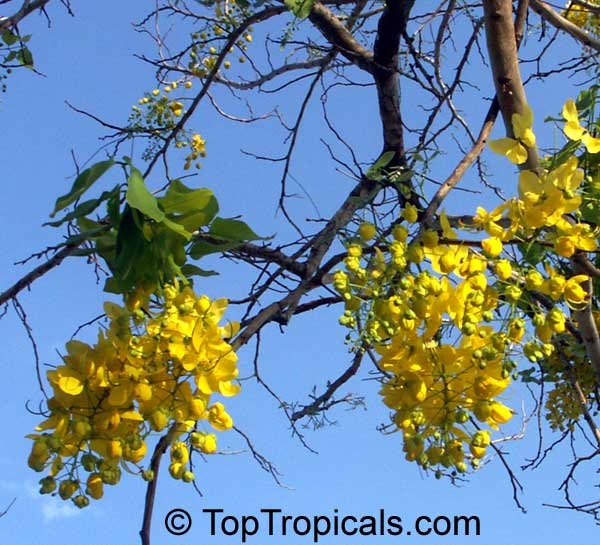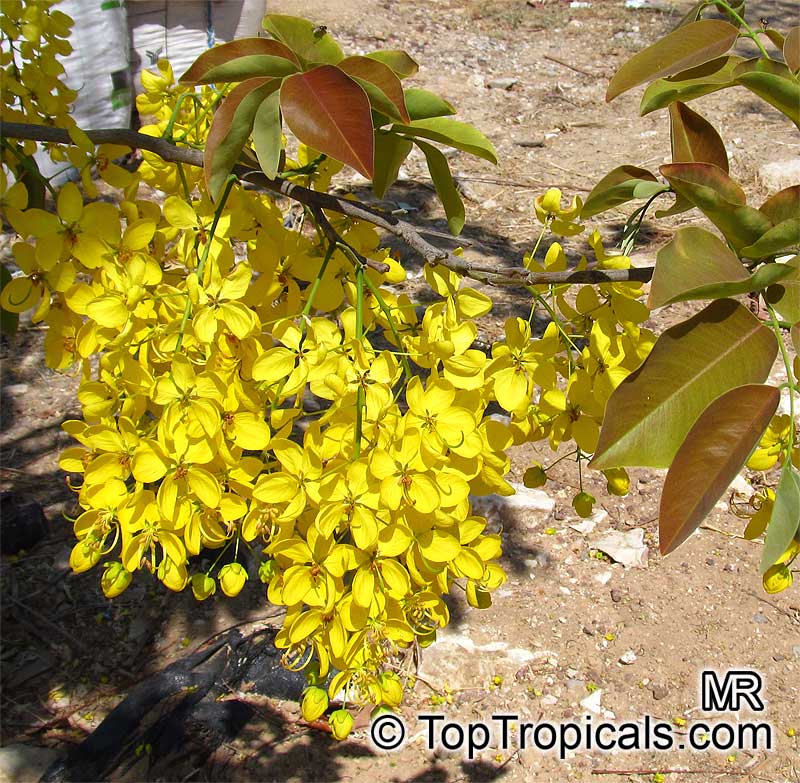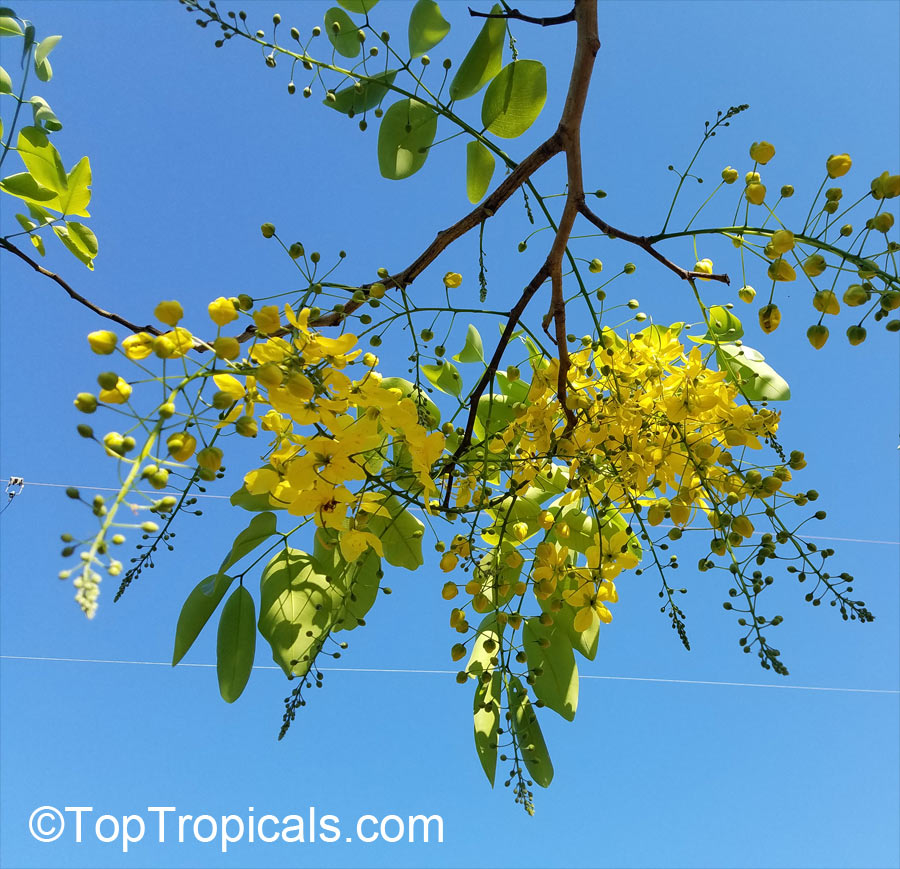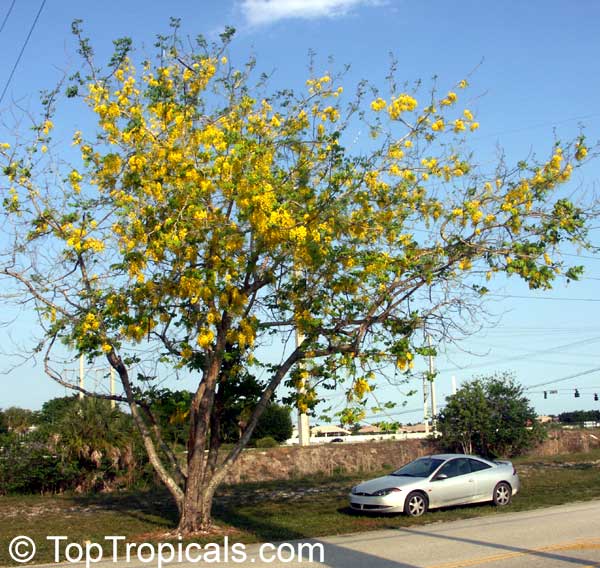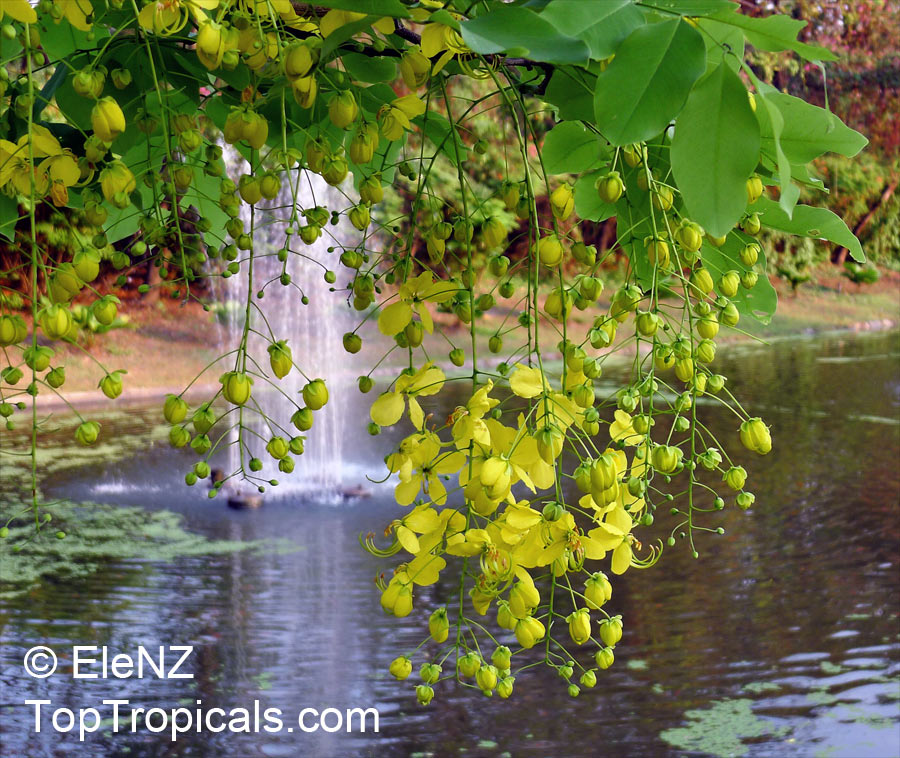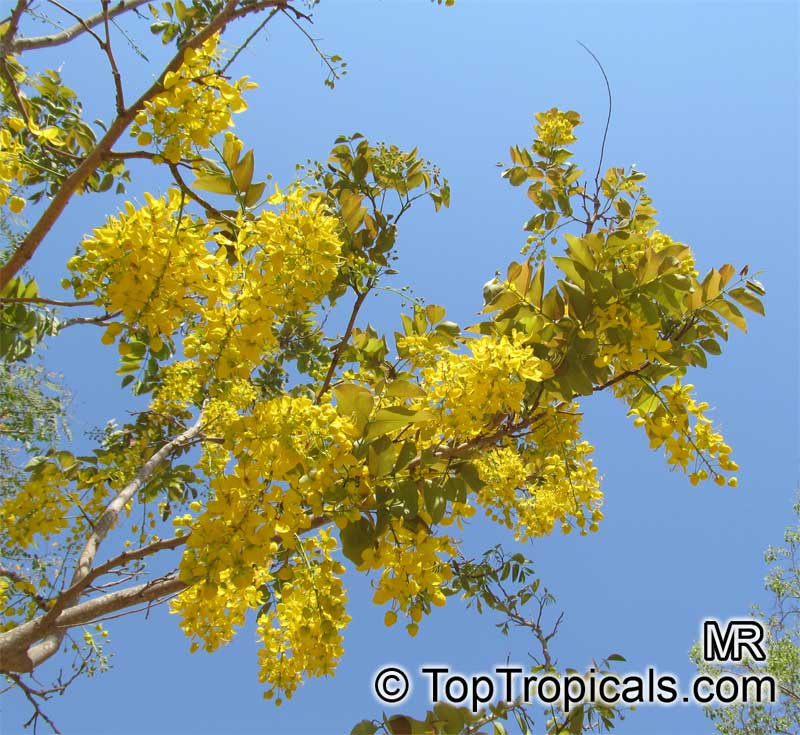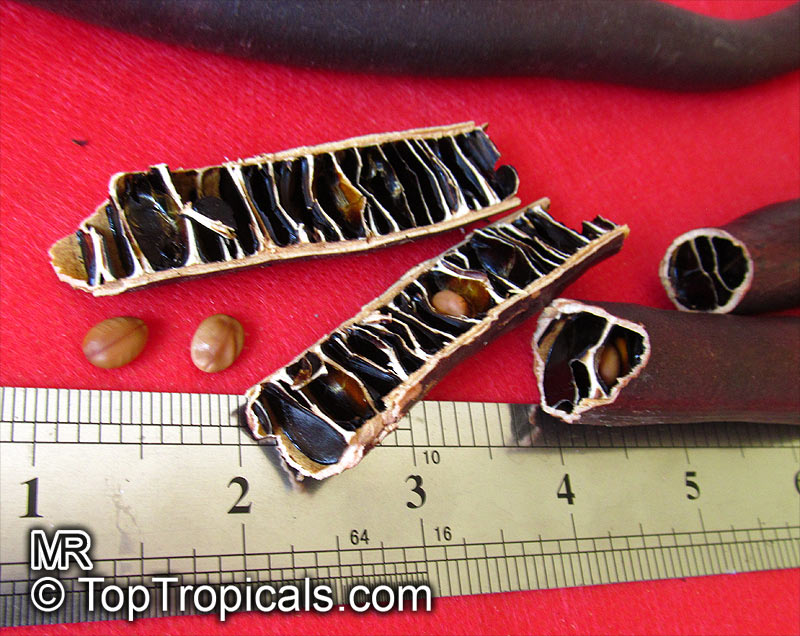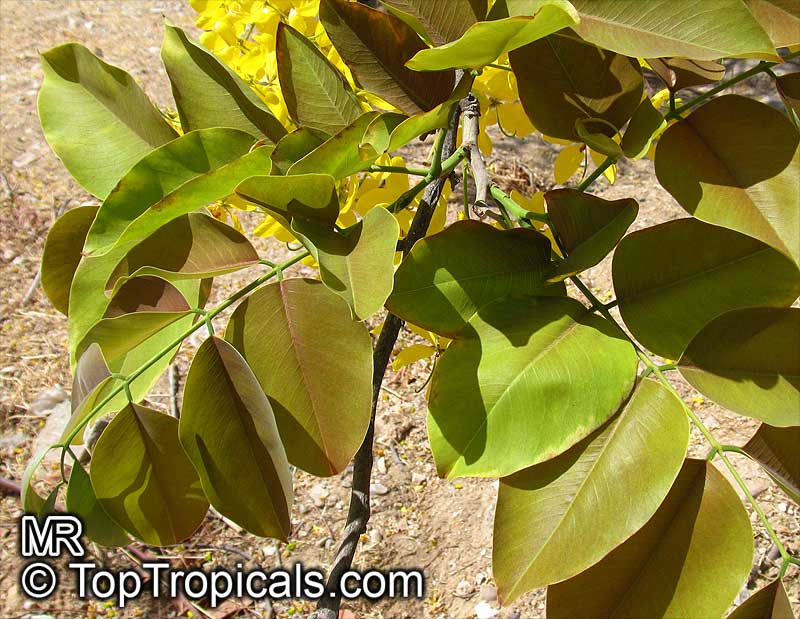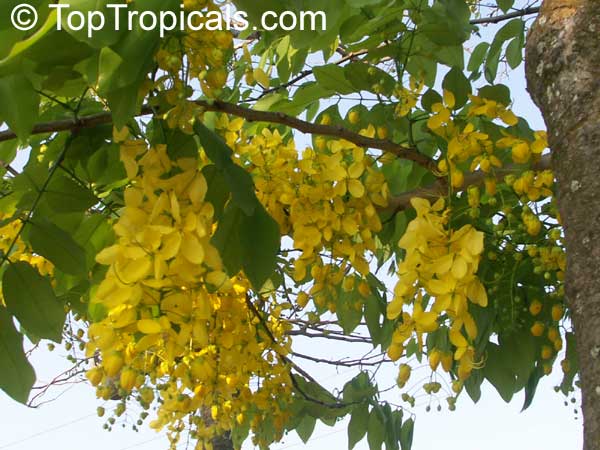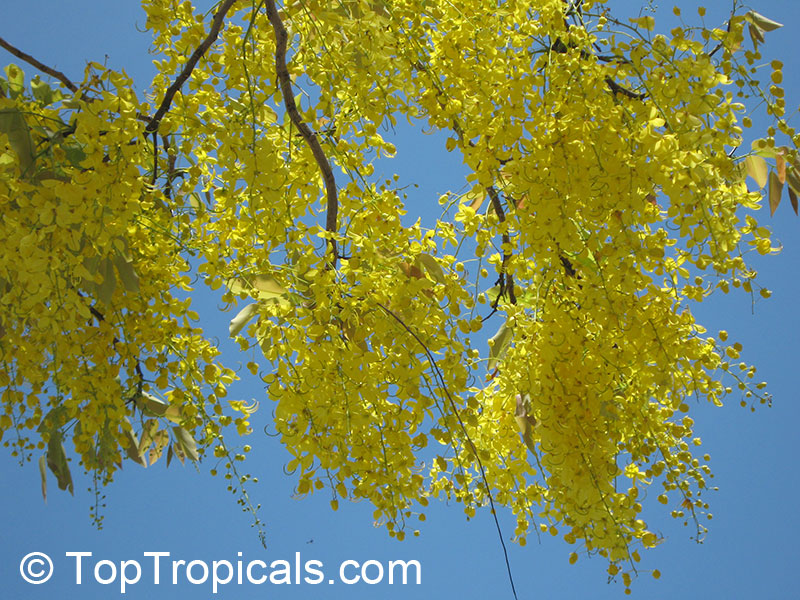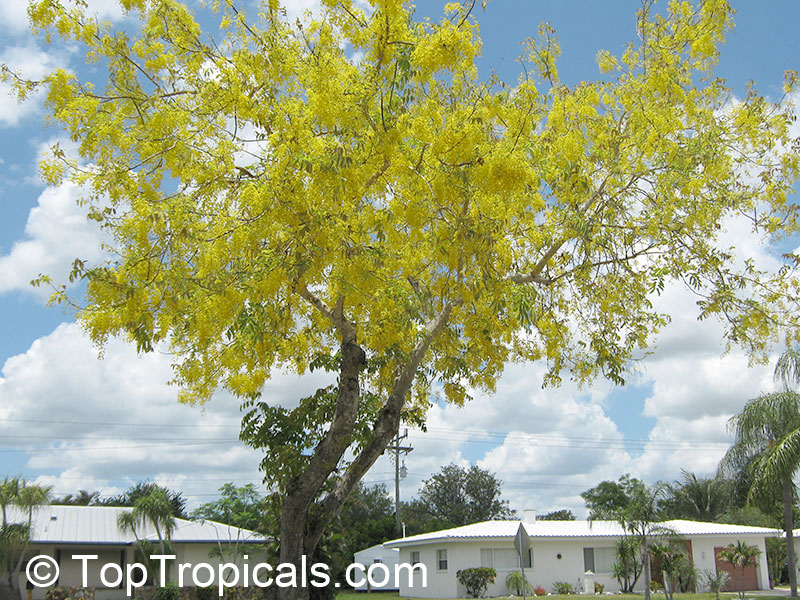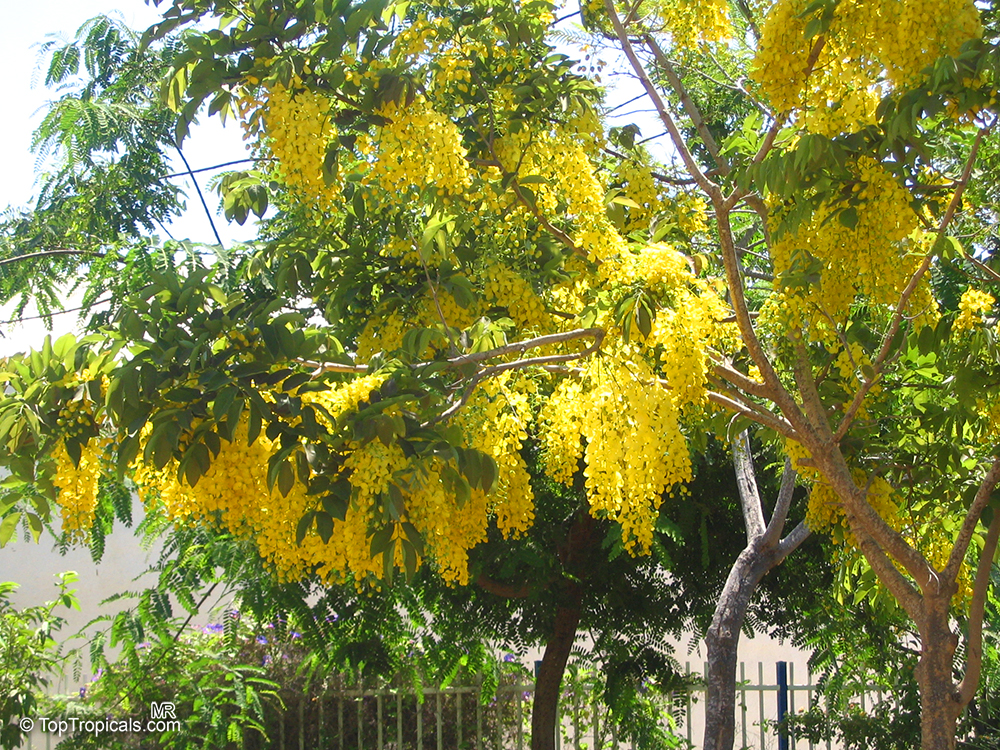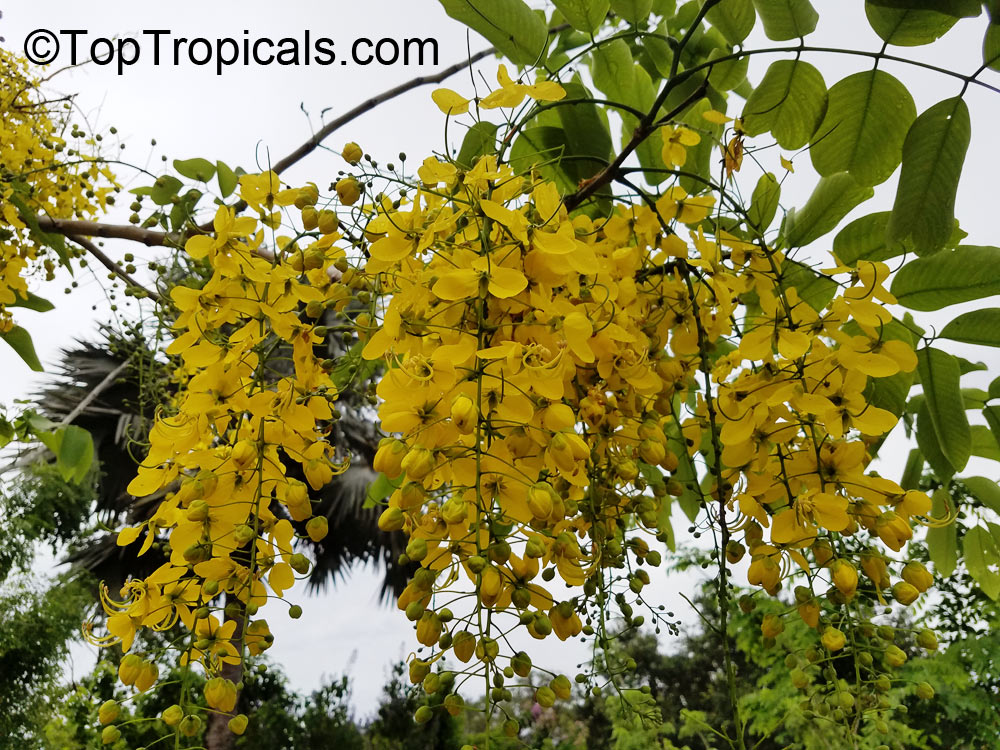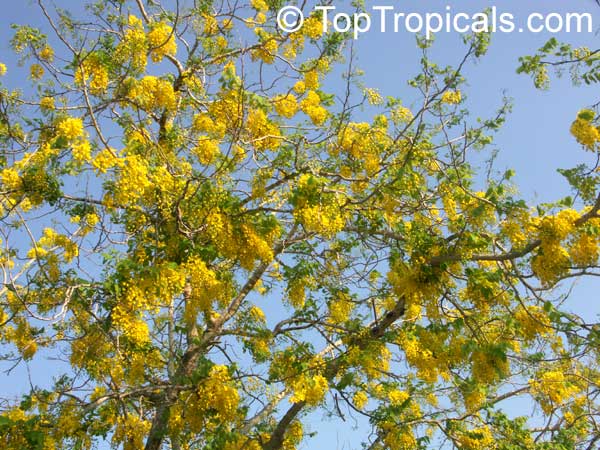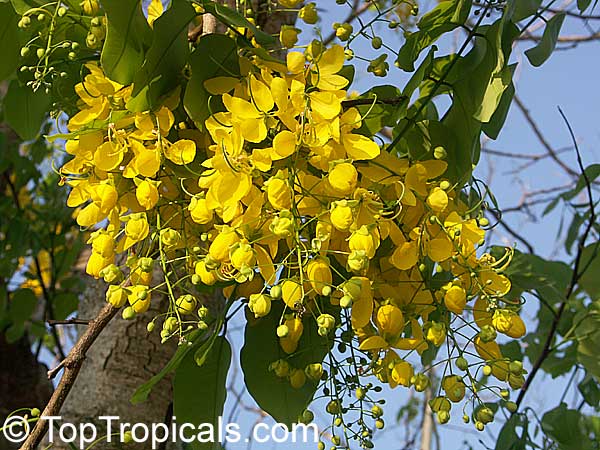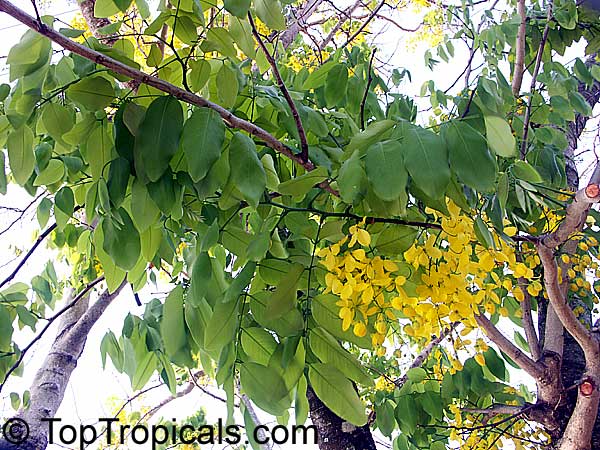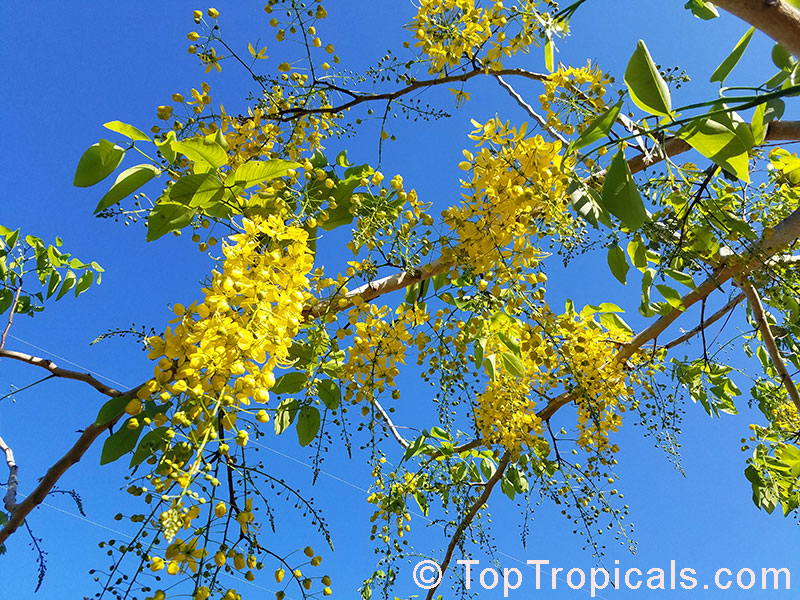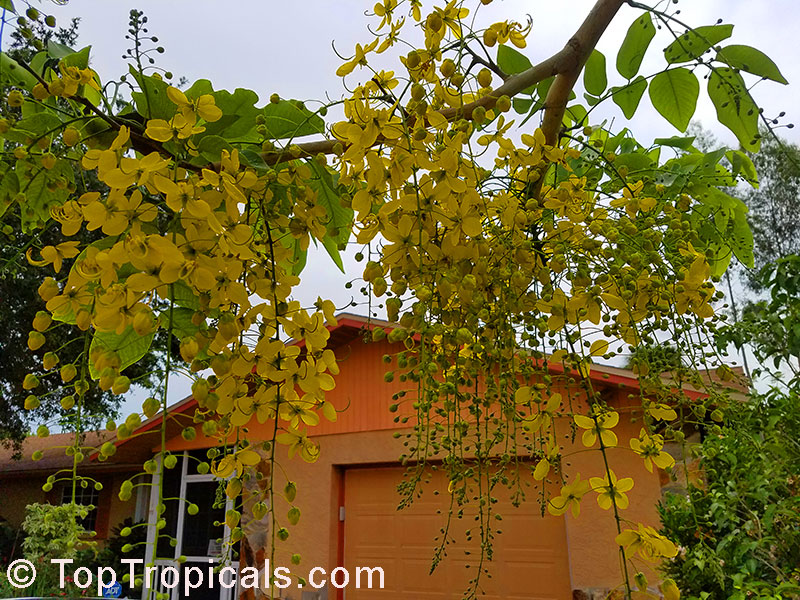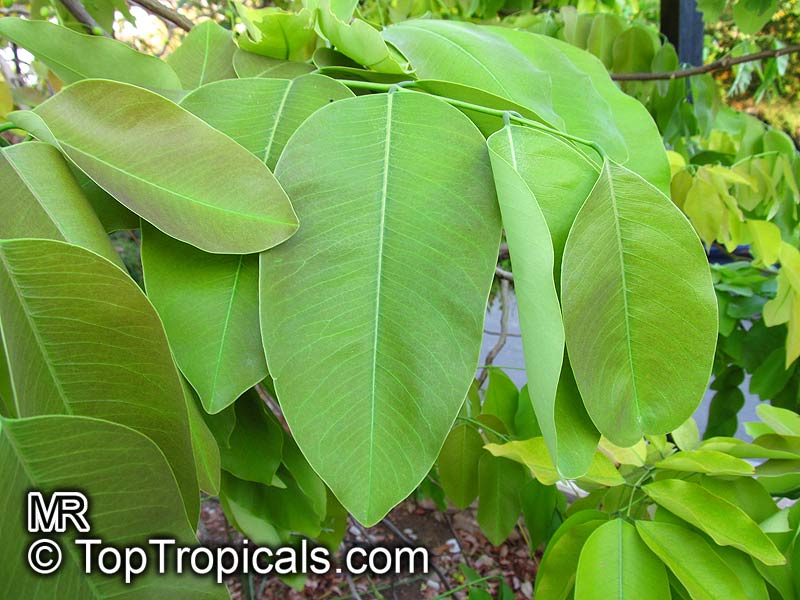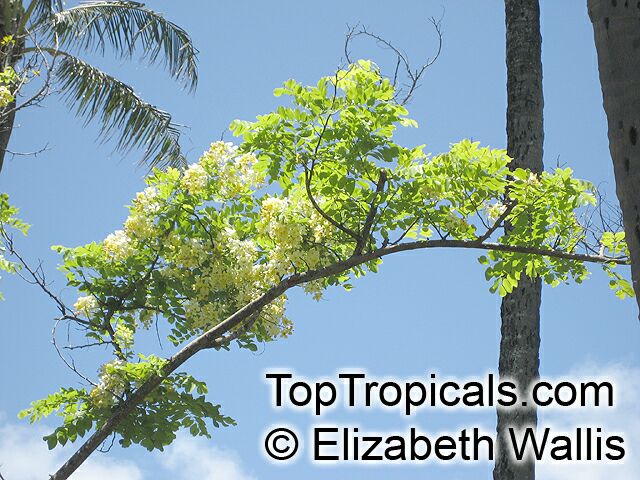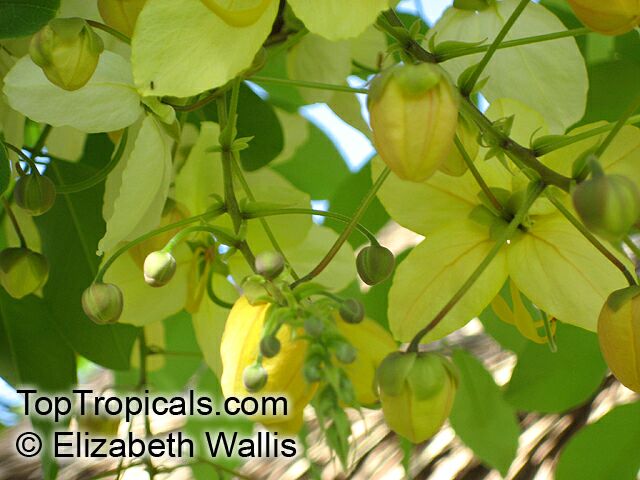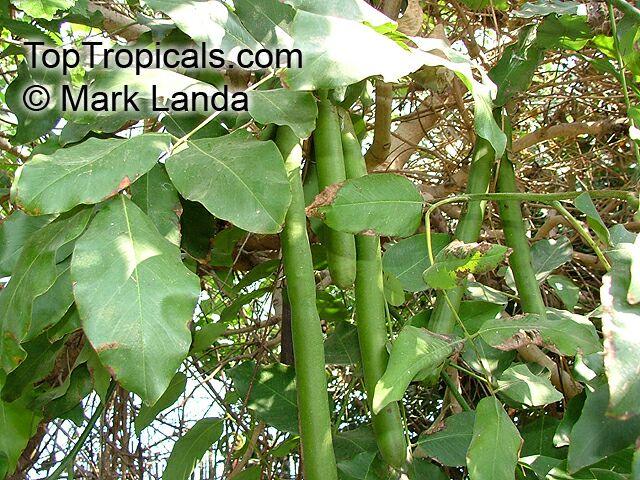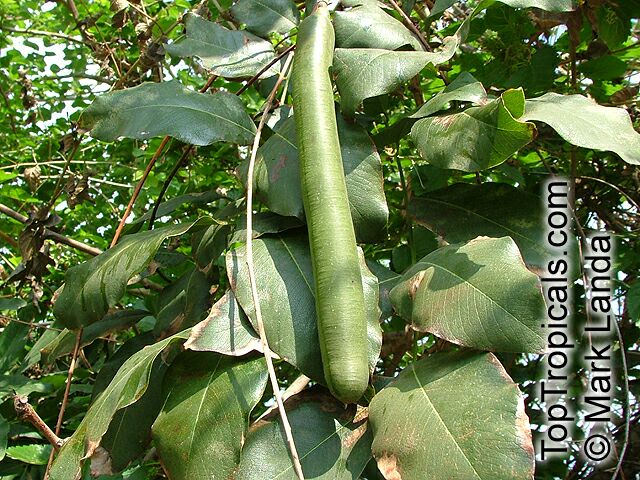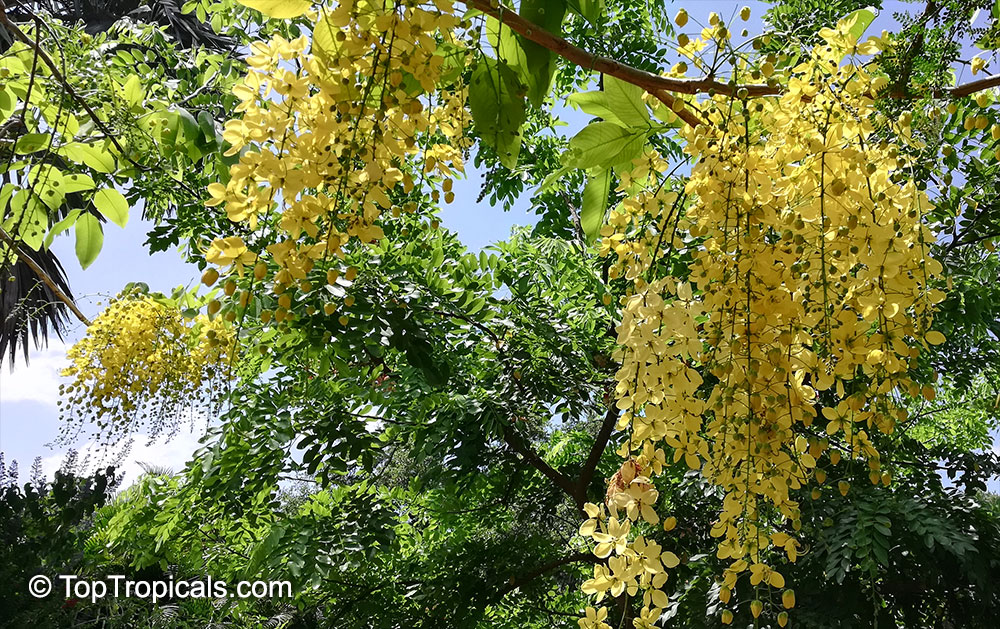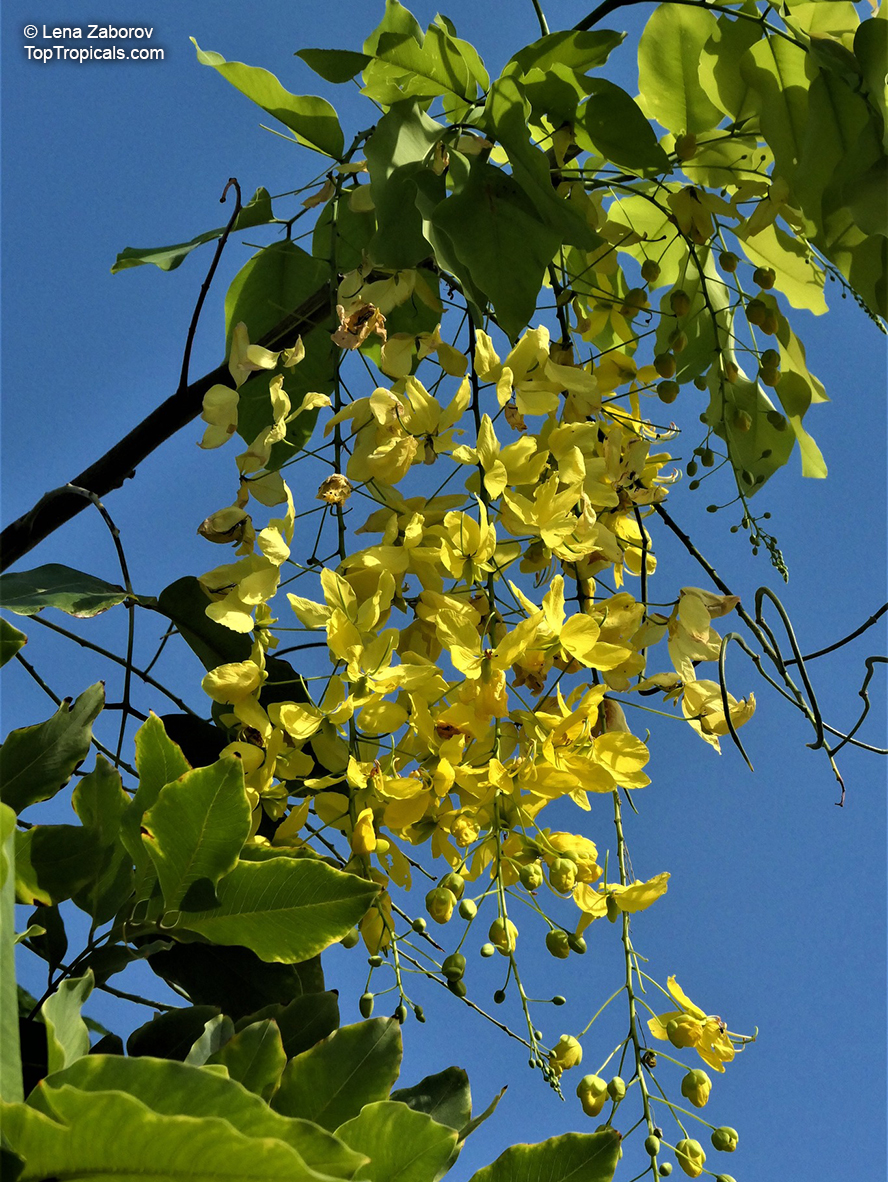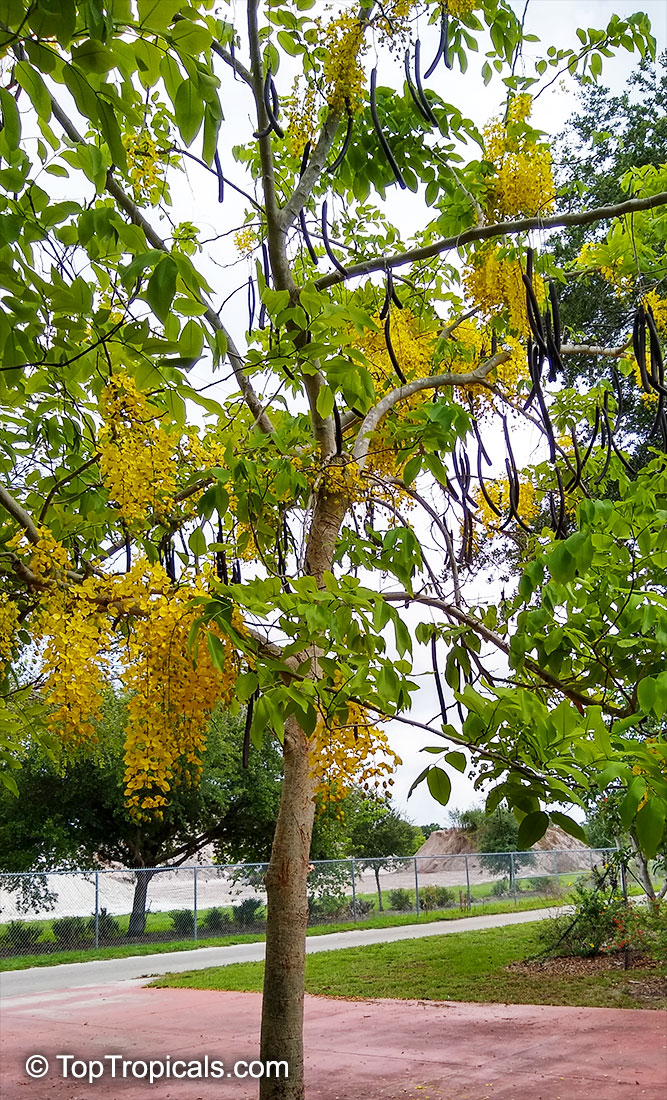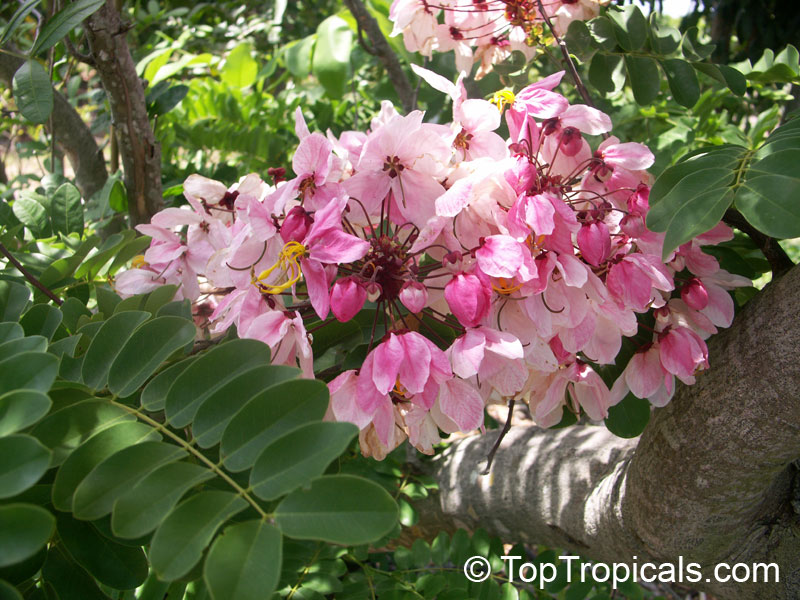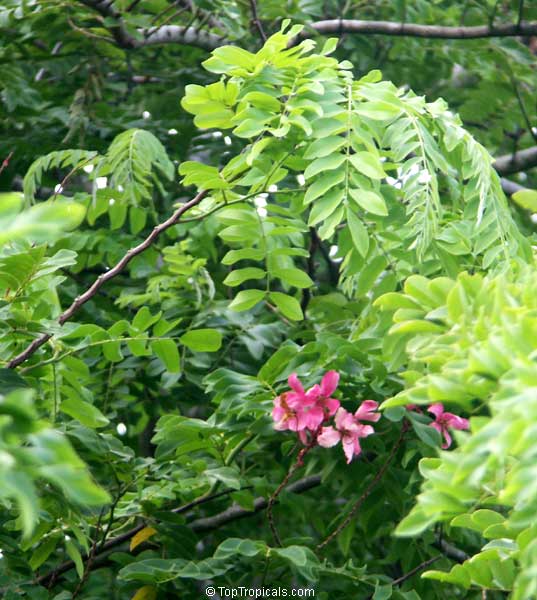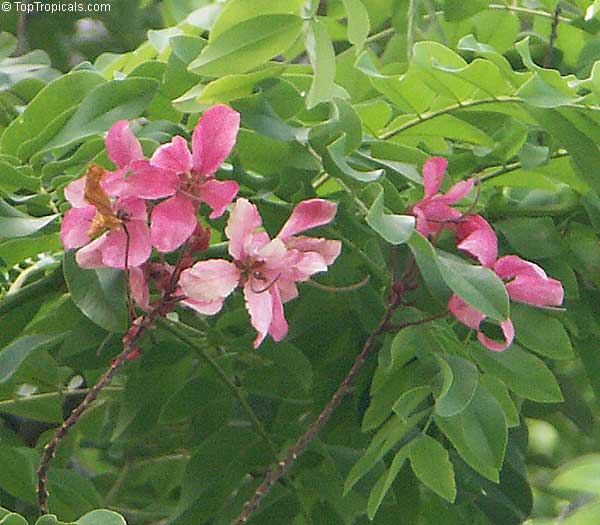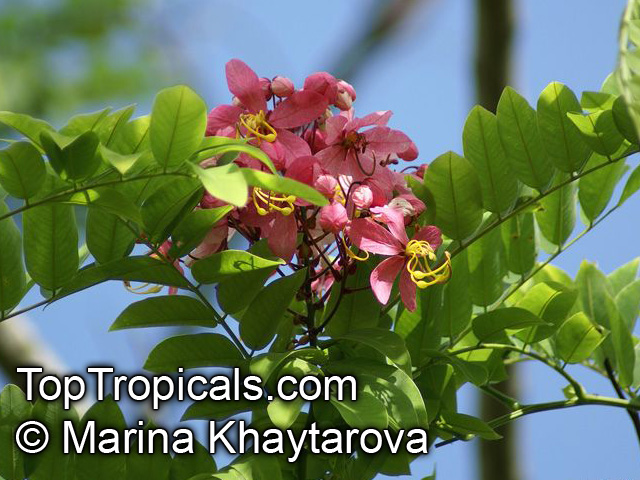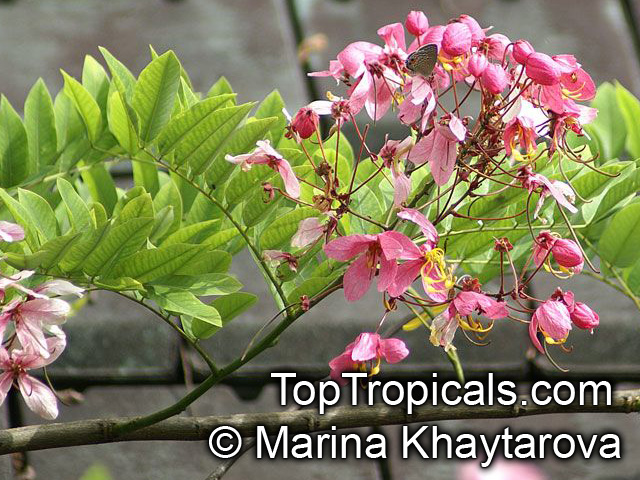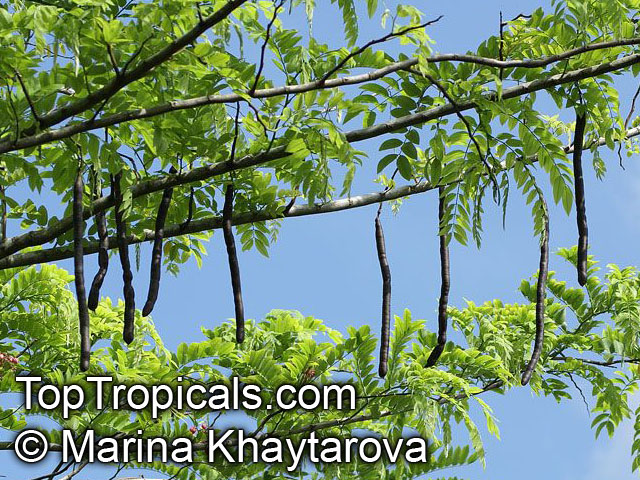Cassia - Plant Encyclopedia Results
Top Tropicals Plant Encyclopedia
| Number of plants found: 34 | Next | 
|
Go to page: | 1 | 2 | 3 | 4 |
Botanical name: Cassia abbreviata
Common names: Long Pod Cassia, Sjambok Pod
Family: Fabaceae
Subfamily: Caesalpinioideae
Origin: South Africa








Cassia abbreviata grows to a height of 5 to 10 feet, and blooms yellow-orange flowers in summer and fall. Requires full sun to semi-shade and moderate water. It has many ethnomedical uses, and the locals refer to it as a healing tree. It is used in traditional medicines as well as home remedies. The bark and leaves are believed to have anti-inflammatory properties. It is also known for its antiseptic and antifungal properties and for its potential benefits in treating skin ailments.
The bright yellow and orange flowers of Cassia abbreviata attract butterflies and hummingbirds to the garden and are extremely fragrant. This evergreen shrub is ideally suited for growth in USDA zones 9-11, where it can thrive when provided with the necessary care and attention.
When planting Cassia abbreviata, it's important to make sure the plant has adequate sun exposure and to keep it in an area with well-drained soil. It's important to water the plant consistently and check the soil often to make sure it's neither too wet nor too dry. The shrubs should also be pruned regularly - every year or two - to ensure it remains densely foliated and not overly large.
In colder regions, Cassia abbreviata can be grown in pots. When growing in pots, it's important to ensure that the container has plenty of drainage holes and to provide the plant with adequate protection against cold temperatures by placing it in a sunny, sheltered area. It's also important to be aware of any potential pests/diseases that may infect the plant and take immediate steps to prevent their spread.
Botanical name: Cassia afrofistula
Common name: Kenyan Shower
Family: Fabaceae
Subfamily: Caesalpinioideae
Origin: East Africa





Cassia afrofistula (Kenyan Shower) is a small tree ranging from 10-20 ft tall and is native to East Africa. This deciduous tree has an upright growth habit and produces dense, dark green foliage. It is a reliable bloomer and produces fragrant yellow and orange flowers in the winter. The flowers are arranged in vertical spikes, giving the tree an exotic and unique look.
This magnificent tree will be a great addition to any landscape. It requires a full sun location and regular watering for best performance. It is extremely attractive to butterflies, hummingbirds, and other pollinators. The leaves and pods are used as medicine in African traditional medicine.
Cassia afrofistula is best suited to USDA Zone 9-11 and can be grown in pots in cold regions. It will require more careful watering in pots and will benefit from a warm and sheltered location. For best results, use a potting medium that drains well and be sure to water regularly in extreme temperatures. When planting, make sure to use well-drained soil and to avoid letting the soil become soggy. Fertilize Cassia afrofistula with a balanced fertilizer in the early spring and midsummer. This will ensure the tree receives plenty of nutrients and will help encourage flowering. Prune the tree lightly in winter or early spring to keep it healthy and in shape.
Cassia afrofistula is a gorgeous, easy to care for tree that will provide a unique and exotic look to any garden. With its beautiful yellow and orange flowers and ability to attract many pollinators, this small tree will make a great addition to any landscape.
Botanical names: Cassia antillana, Senna nitida, Chamaefistula antillana, Cassia aurea
Common name: Golden Rain tree
Family: Fabaceae
Subfamily: Caesalpinioideae
Origin: South Asia





The growth habits of the Cassia antillana varies according to the climate in which it is grown. In USDA hardiness zones 9 through 11, it will grow as a large shrub 5 to 10 feet in height and 8 to 10 feet wide. In the warmer regions of zones 9 to 11, the Cassia antillana can reach the size of a small tree, 10 to 20 feet tall and wide. The tree can also be grown in a pot in cooler regions as long as it is brought indoors or placed in a sheltered location in the winter.
When grown outside, this tree thrives in full sun and regular watering. The foliage of the tree is delicate and a deep glossy green color. As the tree is in bloom, it produces sprays of drooping, yellow and orange flowers. These flowers remain on the tree for a long period of time, providing long-term interest in the garden.
Cassia antillana is an ideal choice for brightening up any spot in the garden. Requiring minimal care once established and thriving in both partial and full sun areas, this tree provides a beautiful focal point with its bright yellow and orange flowers. With regular watering and appropriate care, this tree will provide beauty in the garden for years to come.
Botanical names: Cassia bahamensis, Senna mexicana chapmanii
Common names: Bahama Senna, Bahama Cassia
Family: Fabaceae
Subfamily: Caesalpinioideae
Origin: Florida, Bahamas and Cuba







Cassia is a large genus with some 500 species. Cassia likes full sun and well-drained soil and to bloom profusely require a dry season.
Botanical name: Cassia bakeriana
Common names: Dwarf Apple Blossom Tree, Pink Cassia, Pink Shower Cassia, Wishing-tree
Family: Fabaceae
Subfamily: Caesalpinioideae
Origin: Thailand





A small compact tree with impressive delicate pink flowers, attracting bees and butterflies. Requires regular irrigation. Wind resistant, since branches are very flexible. Perfect choice for small yards and patios, nice container plant.
See Article about pink cassias.
Hybrid:
Botanical name: Cassia bakeriana x fistula
Common name: Apple Blossom Tree
Family: Fabaceae
Subfamily: Caesalpinioideae






A Cassia bakeriana x fistula, commonly known as an Apple Blossom Tree, is a small, compact tree that produces beautiful white and off-white flowers. This deciduous tree, which grows between 10 and 20 feet tall, loves the sun and should be planted in full, direct sunlight. It will thrive with regular watering and is considered to be very wind resistant due to its flexible branches.
Apple Blossom Trees make a perfect choice for small yards and patios and also make a wonderful container plant. Since they are native to USDA Zones 9-11, they can handle mild winter climates, allowing them to bloom all year round and even in the winter. Gardeners living in colder regions may be able to grow and care for this striking tree in a pot or greenhouse.
These trees are attractive to bees, butterflies, and hummingbirds, and when in full bloom, the attractive blossoms produce an impressive display. As one of the most versatile flowering trees, it makes a wonderful backdrop for a garden and adds texture to any landscape.
The Apple Blossom Tree is a beautiful addition to any outdoor space and provides a lovely array of colorful, fragrant blossoms all year long. Its easy care and flexibility make it a great choice for gardeners of all levels and experience.
Botanical name: Cassia brewsteri
Common name: Buy Cigar Cassia
Family: Fabaceae
Subfamily: Caesalpinioideae
Origin: Australia








A variable, small to medium sized tree with very attractive, fern like foliage and very decorative spikes of hanging yellow to red flowers in autumn.
Botanical name: Cassia didymobotrya
Common names: Popcorn Cassia, Peanut Butter Senna
Family: Fabaceae
Subfamily: Caesalpinioideae
Origin: Tropical East Africa







A shrub or small tree producing golden-yellow flowers with a distinct scent of peanut butter that open from brown buds in late summer and autumn. It is common in disturbed areas and grows rapidly. This elegant tree has arching branches with leaves that are feather-like. Also called Popcorn Cassia, because it smells like fresh cooked, buttered popcorn when you run your fingers through the leaves and then smell. It blooms beautiful large clusters of sunny yellow flowers. Small, individual leaflets form alongside the leaf stalk. Sow seed at 64-70 degrees F in a standard potting mix. Grows in full light, water freely during growing season and feed once a month.
Recommended Fertilizer: SUNSHINE Megaflor - Bloom Nutrition Booster
Ordering seeds info
RECOMMENDED SUPPLIES:
Seed Germination Mix #3, professional grade
SUNSHINE-Epi - Seeds and cuttings booster
SUNSHINE Bombino - Young Plant Booster
Botanical name: Cassia fistula
Common names: Golden Shower Tree, Indian Laburnum, Ratchaphruek
Family: Fabaceae
Subfamily: Caesalpinioideae
Origin: South Asia





This is a national flower of Thailand and one of the most impressive cassias. From early spring through summer, it displays beautiful cascades of golden flowers. Cassia is a large genus with some 500 species, among which are a number of highly attractive flowering trees. To many tropical gardeners, the most beautiful is Cassia fistula. This is a medium to large tree with ovate, pointed leaflets; when these drop, usually in the dry season, masses of bright gold flower clusters appear on almost every branch. Cassia likes full sun and well-drained soil and to bloom profusely require a dry season.
Hybrids:
Recommended Fertilizer: SUNSHINE Megaflor - Bloom Nutrition Booster
Recommended Fertilizer: SUNSHINE Megaflor - Bloom Nutrition Booster
7 gal pot. More developed root system, thicker trunk and branches. Plant height depends on growing season and variety. Dwarf varieties are slow growers and may be shorter. Contact us for exact size description if size/height matters to you. 7 gal plants may be shipped separately from other items by Ground service due to large size. See here time in transit (business days, excluding Sat-Sun!)
Botanical name: Cassia javanica
Common names: Apple Blossom Tree, Apple Blossom Shower
Family: Fabaceae
Subfamily: Caesalpinioideae
Origin: Indonesia






A small tree with a wide-spreading crown and pale-green leaves. A very showy summer bloomer. Magnificent flowers bloom with petals that change in color from pale red to dark red then paling again. A great houseplant to grow! Flowers range from white to pink on the same branch and appear in dense clusters. This tree is in bloom for over three months. Grow in full light, water freely during growing season and feed once a month.
See Article about pink cassias.
Hybrid:
Recommended Fertilizer: SUNSHINE Megaflor - Bloom Nutrition Booster
Last one
| Next |  |
Use link to repeat this search:
https://toptropicals.com/cgi-bin/garden_catalog/cat.cgi?find=Cassia&search_op=and&keyword_op=and&language=e&number=10
&no_change_lang=1&user=tt&sale=1&first=0
